Another Bouncing Ball: December 2009 Archives
Effective immediately, the Albright-Knox Art Gallery is extending free admission (and parking) to all active-duty United States and Canadian military members and their families, including Guard and Reserves. Good for them. (more)Excellent idea. The small cost to the bottom line would reap a big harvest in good will. In the Northwest, only the Seattle Art Museum and the Tacoma Art Museum offer a military discount, and it's just for the the person serving, not families. With the military engaged in two wars, their families are serving too. In the new year, art museums need to honor this effort with a free ticket for all concerned. (The Frye can't rise to this occasion because it has already surpassed it, being free admission for everybody all of the time.)
Related: Sympathy for soldiers photo essay here. Jon Stewart on the government's shameful efforts to avoid paying for war-related health care injuries, here. Finally, bringing the war home: Owen Mundy through projections and Remi Gaillard through an invasion of a vacation beach:
U.S. News & World Report claims that the jobs for museum curators are poised to go boom, making it one of the top 50 career choices in 2010, here via Henry curator Sara Krajewski. She noted that she'd like to see their back-up research. Given the starved state of the profession in the past decade, this promise of prominence is hard to believe.
The mind is a terrible thing to waste on new-age platitudes. This one is 40 years old, proving once again that belief needs no evidence to stay afloat.
Who's missing from the art audience? Real Clear Arts has the answer, or at least, an exploration of the question.
From the department of still good: Allan McCollum's 2005 interview with Harrell Fletcher.
From John Lopez in the L.A. Times: What it means to be an artist now. The subtitle could be, Stop the world, I (might) want to get off.
From Christopher Knight:
In an October lecture at the Smithsonian, critic Dave Hickey noted that, in the Internet's vast territory, niches are the equivalent of villages. And art does poorly in the homogenized, provincial ether of a village. To thrive art needs cities, where cosmopolitan diversity, conflict and sheer accident are the norm. (more)Uh, no. Tell that to Cezanne, who preferred Provence to Paris. Some artists want to be alone. (From William Carlos Williams, who liked New Jersey better than New York, "I am lonely, lonely./ I was born to be lonely./ I am best so!"). Where doesn't count next to what, and not all whats need an urban setting to flourish.
Also from Christopher Knight:
One of the funniest essays at the tail end of 2009 was Knight's response to Jerry Saltz. In his homage to Jeff Koons, here, Saltz could have been clearer about the time-line of the many appearances of Koons' flower-filled Puppy. Fair enough. But here's the thing about Knight, one of the best critics in the world. He tends to be all or nothing. In the powerful sweep of his argument, the thing that actually occurred can get lost.
A suspiciously simple sense of life is that it is in any one man conclusive. (Robert Creeley)
Claude Zervas
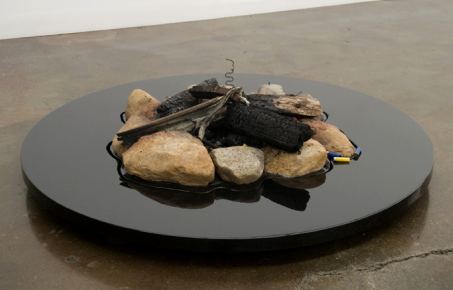 David Hammons
David Hammons Mark Mumford
Mark Mumford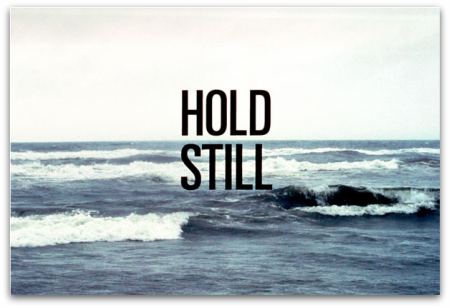 Judy Cooke
Judy Cooke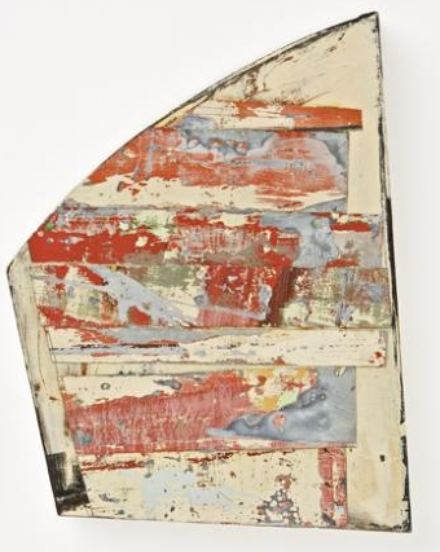 Ed Ruscha
Ed Ruscha Nola Avienne
Nola Avienne David Lvie
David Lvie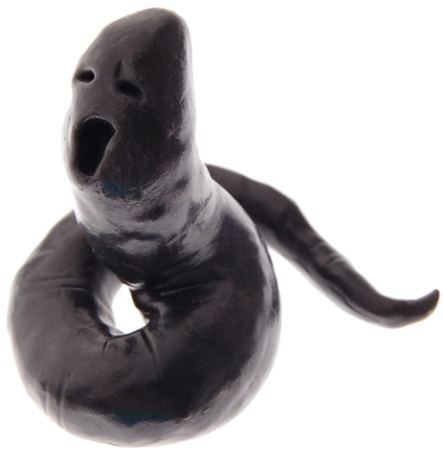 Yuki Nakamura
Yuki Nakamura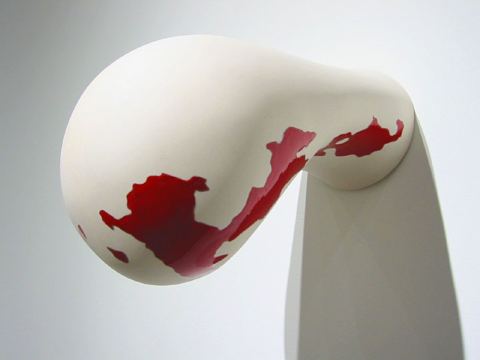 Cris Bruch
Cris Bruch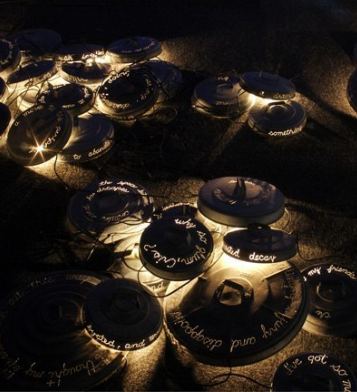 Paul Lee
Paul Lee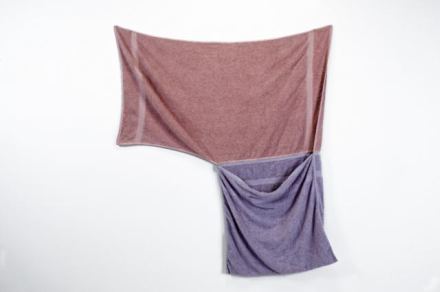 Ellen Ziegler
Ellen Ziegler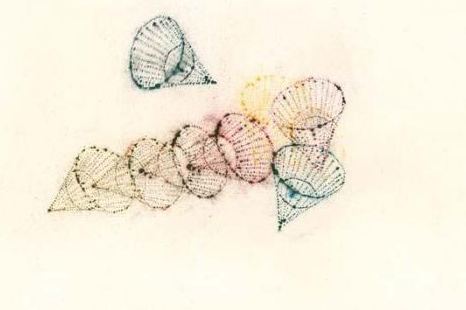 Charles Krafft
Charles Krafft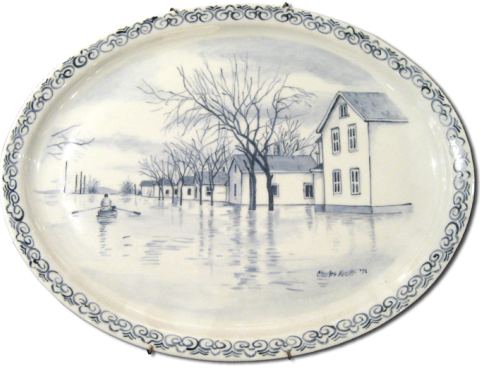
Sonogram of the Blue Jay Monoprint, 2005, 12 x 10 3/4 inches.
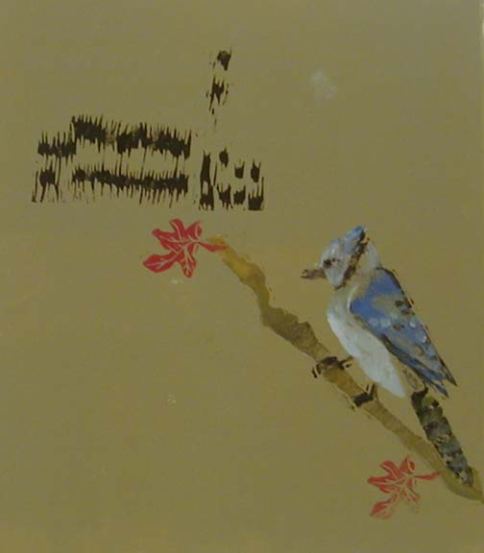 Although her paintings often have an odd and weightless delicacy, they are never finished to the point of refinement but seem instead to have been pulled into view, dirt still clinging to their colored roots.
Off and on for nearly a decade, she has painted birds surrounded by the visual equivalent of their song. No one else has brought melodious plots to life by means of oil paint on canvas and monoprint on paper. (more)
Although her paintings often have an odd and weightless delicacy, they are never finished to the point of refinement but seem instead to have been pulled into view, dirt still clinging to their colored roots.
Off and on for nearly a decade, she has painted birds surrounded by the visual equivalent of their song. No one else has brought melodious plots to life by means of oil paint on canvas and monoprint on paper. (more)Sandvig is one of the artists featured in the first part of a homage to her dealer, Francine Seders. At 76, Seders has been at the helm of one of the best galleries in the region since 1966, focusing on painting.
Part one runs through Jan. 10 at the gallery and features, besides Sandvig, Jacqueline Barnett, Dina Barzel, Dina Bolinger, Alfonse Borysewicz, Jeffery Burgert, Dan Carmichael, Lauri Chambers, Caryn Friedlander, Emily Gherard, Jon Gierlich, Philip Govedare, Juliana Heyne, Anne Hirondelle, Denzil Hurley, Robert Jones, Diann Knezovich, David Kuraoka, Spike Mafford, Merle Martinson, Robert Mirenzi, Ben Frank Moss, Joanne Pavlak, Julie Shapiro, Michael Spafford, Margaret Watson, Guy Anderson, Michael Dailey and Boyer Gonzales.
Part 2 runs Jan. 15 to Feb. 14
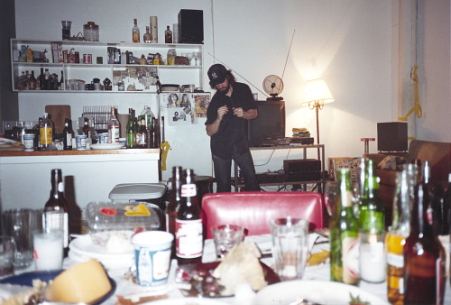 Mark Takamichi Miller Thieves: Man At Party
Mark Takamichi Miller Thieves: Man At Party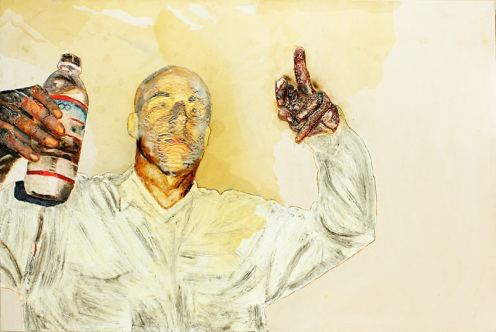 Sean M. Johnson, Five Drinks In
Sean M. Johnson, Five Drinks In Jenny Heishman, Bogie
Jenny Heishman, Bogie Elizabeth Sandvig, Ice Cream
Elizabeth Sandvig, Ice Cream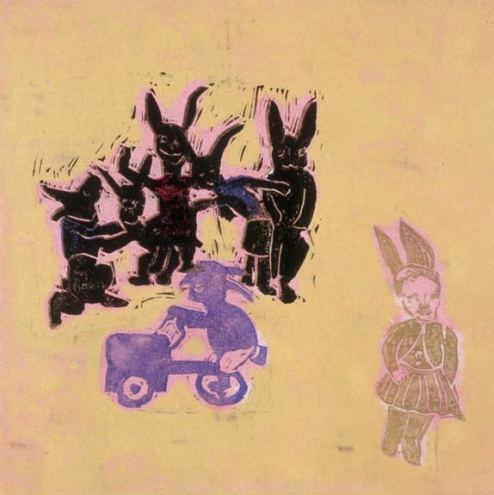 Mark Mumford, We Are All In This Together
Mark Mumford, We Are All In This Together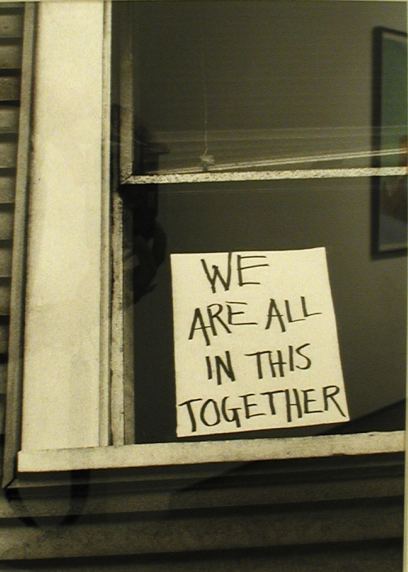 Alice Wheeler, Collins Ave., Miami, 2007
Alice Wheeler, Collins Ave., Miami, 2007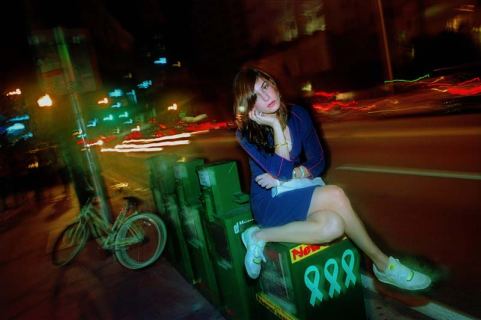
 While we're on the subject of no, there's always Peter Schjeldahl on Richard Prince:
While we're on the subject of no, there's always Peter Schjeldahl on Richard Prince:The immense art-world success of Richard Prince, the subject of a large and seductive retrospective at the Guggenheim, depresses me, not that I can gainsay it. If "quintessential artist in a generation" were a job opening, Prince, fifty-eight years old, would be an inevitable hire, having hit no end of avant-gardist sweet spots since the late nineteen-seventies in photography, painting, and sculpture. His contemporaries Cindy Sherman and, off and on, Jeff Koons are better, for stand-alone works of originality, beauty, and significance. But they don't contest Prince's chosen, Warholian ground as a magus of contemporary American culture. (Koons tried, but his attempt was too weird for comprehension, let alone assent.) Prince's works make him an artist as anthropologist, illuminating folkways by recycling advertising photographs, cartoon and one-liner jokes, soft-core pornography, motorcycle-cult ephemera, pulp-novel covers, "Dukes of Hazzard"-era car parts, celebrity memorabilia, and other demotic flotsam. (more)
Roberta Smith's review of Nauman's current exhibit at the Philadelphia Museum of Art is splendid:
Even after four and a half decades, Mr. Nauman still turns out videos, sculptures, installation works and sound pieces that tend to be stripped to the bone, no-frills, unfamiliar and even alien in form. They don't "present" as art, yet they lodge in the mind and won't let go, disorienting, irritating, inundating and exhilarating the senses. And with time, the best Naumans make clear their art-ness, laying bare life's basic experiences, distilled and compressed.(Small gripe about the NYT: Its links policy is absurd. NYT links lead only to NYT stories. There's no way to click through to something else, as if once you're in, you need nothing else. Yes, NYT, you are the best, but you're not the only.)
More on Roberta Smith: John Perreault is absolutely right about her review of Roni Horn. Smith missed Horn's meaning by miles. Perreault is also convincing on his thoughts about museum installations in general. (In short: go lean.)
Horn - Pink Tons
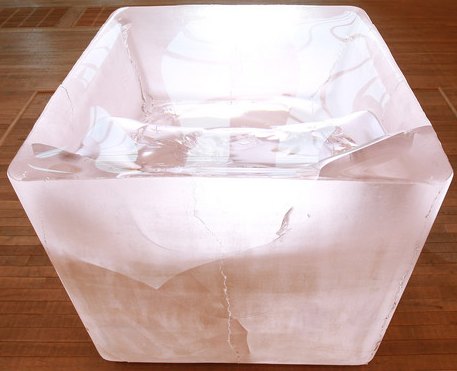 I'd
love to see the above 5 tons of pink glass in Seattle. That girly-girl
hit of Minimalism would be the elephant in our living room.We might stumble upon it and learn something.
I'd
love to see the above 5 tons of pink glass in Seattle. That girly-girl
hit of Minimalism would be the elephant in our living room.We might stumble upon it and learn something.Home team: Jen Graves' essay on Miami topped anyone else's.
But the annual art-world migration to Miami is not really about art. It's about the art world. About money, people-watching, and tropical escape (the water is so salty off Miami Beach that a body floats uncomfortably high in the cool December air). About rich people trying to look smarter and vice versa. About, as Ben Davis has written, the endless asking of the question "How are sales?" It almost feels beside the point, like a bonus, that this is pretty much the only way to get this much contemporary art in one place at one time--a painting in the shape of a trench coat, a bin of musical garbage, a sculpture consisting of an endless supply of white wrapped candies, fireworks momentarily spelling the word "RECESSION" in the night sky, documentary photographs of Texas prison lifers, a New York Times dipped in 24-karat gold, a video in which a young Iranian prostitute is tormented by men without faces (Shirin Neshat's Zarin: unforgettable), electronic billboards with messages such as "Confusing yourself is a way to stay honest," mesmerizing three-dimensional mirror mosaics by an 85-year-old Iranian woman (Monir Shahroudy Farmanfarmaian), a male mannequin with a lifelike crotch, a performance in memory of the Tlatelolco student massacre in Mexico, graffiti on the streets and in the galleries, drippy ceramics (by Seattle's Jeffry Mitchell), droopy textiles (by Josh Faught, based in Eugene, Oregon, and recent Seattle Art Museum Betty Bowen Award winner), shoe-shine stations painted like shrines, geometric abstractions made in thick, silvery pencil. That and Picassos, Warhols, Duchamps, Ruschas, Flavins, Richters, and even, this year, a religious painting by the turn-of-the-20th-century Belgian James Ensor, whose retrospective this year at the Museum of Modern Art was a sleeper hit. And paintings (primary-colored, splashy) by Sylvester Stallone.I hope the male mannequin with a lifelike crotch is Charles Ray's. Otherwise, do your own work, anonymous artist mentioned in passing by Jen Graves.
What artists read: This month Tyler Green began a series on what featured artists read. Great idea, but sometimes I don't want to know. Reading that Kate Shepard values most a book by Mary Baker Eddy handed me a problem that I don't need. When looking at Shepard's work, I'm going to have to force myself to forget that she's a fall-for-anything fool. If artists I admire vote Republican, drive a Hummer, believe that civil rights need not include gays and lesbians or that the faithful can pray away cancer, I don't want to know it. Jackson Pollock had the right idea. He kept what he was reading locked away, lest visitors drawn from that information conclusions that distract them from the work.
Hey Hey We're the Monkeys: On a hopeful note, Terry Pratchett, wine glass in hand, held forth on stage about the state of things:
We are shaped by the universe to be its consciousness. We tell the universe what it is. ...I find it more interesting (than religion) that a bunch of monkeys climbed down from their trees to build this and build that, to build everything. We're monkeys. Our heritage is (when) in difficulties to climb a tree and throw shit at other trees. That's so much more interesting than being a fallen angel...The story of evolution is more interesting than anything in the Bible. It teaches us that stars are not important. Street lamps are important. As far as we know, there are only a few million of them in the universe. And they were built by monkeys. Admittedly, we do err, as when we made Tony Blair prime minster. But given where we started from, crawling up some beach somewhere, we actually haven't done that badly.Very nice about street lamps, but Pratchett might want to reread Milton. Christianity doesn't claim that we are fallen angels. The fallen angels are devils, the greatest being Satan, the hero of Paradise Lost. Landing in the abyss, he asked, "What do mine eyes with grief behold?" A monkey wrote that. Impressive, for a monkey.
Back to street lamps. Sheila Klein's Vermonica.
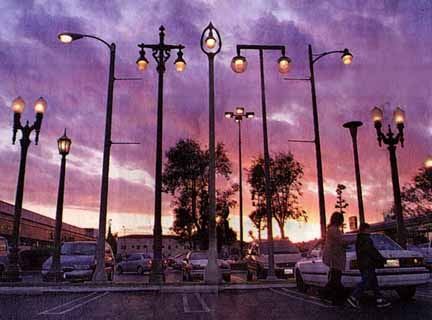 Installed in 1992, it predates by 16 years a similar piece in the same town by the great Chris Burden. (Story here.) Monkeys have the unfortunate habit of copying each other and giving the more famous monkey all the credit. Los Angeles has room for both, but for LA critics to treat hers as if it doesn't exist is weird.
Installed in 1992, it predates by 16 years a similar piece in the same town by the great Chris Burden. (Story here.) Monkeys have the unfortunate habit of copying each other and giving the more famous monkey all the credit. Los Angeles has room for both, but for LA critics to treat hers as if it doesn't exist is weird. Rattle
All the artists in Rattle (curated by Sierra Stinson) were students of the dazzling Gretchen Bennett when she taught at Cornish. Rattle has no duds although possibly a few too many toenails. The artists include: Amelia Layton who paints the unraveling world (geometries that trail off into recycling, birds who've wandered out of their forests, hipsters who've forgotten their lines in the play); Michael Rioux, who has a fresh appreciation of decay, and Brett Walker , who is hilarious. (Also, Morgan Johnson, Joel Kvernmo, Rosa Lazzarini, and Mckenzie Porritt, along with a sculpture and colored drawing from Bennett, both worth the trip all on their own.
Rioux:
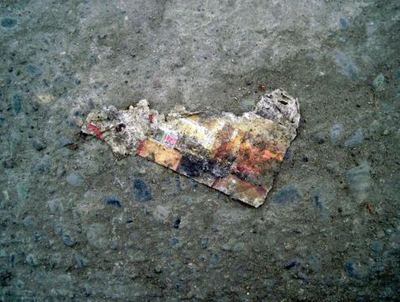 (Taking over from Chris Crites, Stinson will be curator of Joe Bar starting in January. That'll be fun.)
(Taking over from Chris Crites, Stinson will be curator of Joe Bar starting in January. That'll be fun.)The Future
TARL is the underground version of the recently demised Crawl Space, which, as its title suggests, knew its way around the back entrances to things. TARL currently exists basement of Jessica Powers and Matt Browning's Capitol Hill home but looks forward to a nomadic existence.(TARL organizers are Powers, Browning, Rebar Niemi, Anne Mathern and Brendan Jansen.)
First up at TARL are Raymond Boisjoly and Ryan Peter. Their charmingly insufficient back-to-the-future installation starts with a musical question: How else to build a future but from a child's version of the past? It features a plywood dinosaur with a tape playing the sound of a garbled human voice freely impersonating a dionosaur's as a tribute to Robert Morris's Box with the Sound of Its Own Making (1961) at Seattle Art Museum.
I'm in love with their wood-grain prints of similar ancestor figures, some of which are sliding off the wall.
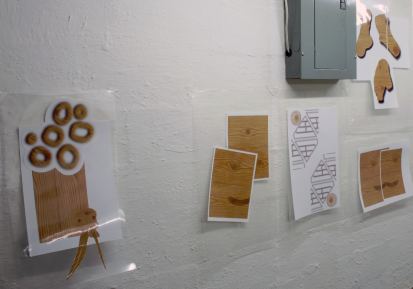 Now that Yoko Ott is winding up her tenure at the Hedreen Gallery (She left to direct Open Satellite), Seattle University needs a Hedreen Gallery director. I nominate Powers. She'd be perfect.
Now that Yoko Ott is winding up her tenure at the Hedreen Gallery (She left to direct Open Satellite), Seattle University needs a Hedreen Gallery director. I nominate Powers. She'd be perfect.Does it mean an artist who scores her first gallery show? (Tell it to Carmen Herrera.) How about someone who after years of toiling in a regional setting breaks onto a global stage? Maybe it's someone who finally connects meaning to matter after a prelude of dilly-dallying. Is it someone whose sales tip over into something close to a living wage or someone who can pass as a discovery for critics?
Artists who find a style and stick with it for decades can still be called emerging when they manage to attract an audience. In other minds, however, those same artists might never rise to the level of emerging. They've broken through nothing.
Brett Walker takes his lead from the brown burrowing mole. If he emerges into your yard, you'll know it. Walker is part of Rattle My Cage at Vermillion Gallery, through Jan. 3.
The Emerging Artist, 2009
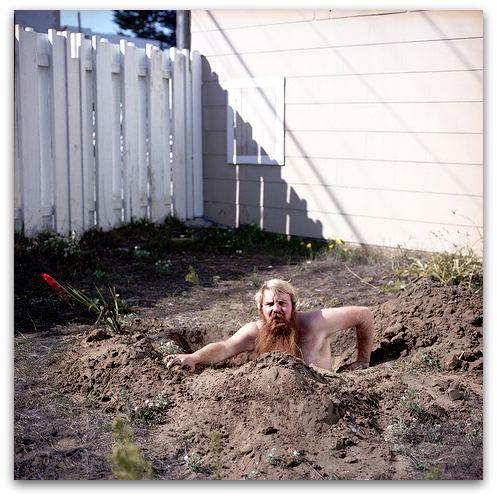
(Image of the ground floor of the museum's expansion via. Suspended from the ceiling, Cai Guo-Qiang's Inopportune: Stage One, 2004)
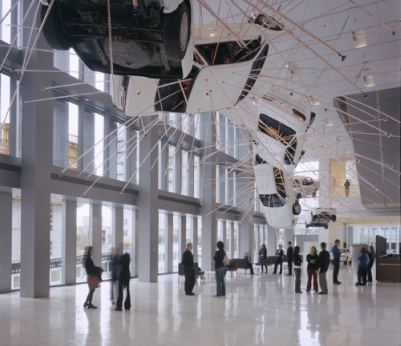 What could go wrong? A bank is where the money is. But SAM got clobbered anyway, because the bank in question was Washington Mutual. At Washington Mutual, deals were backed by hot air instead of cold cash. When WaMu was seized by federal regulators on September 26, 2008, SAM was left holding an empty bag that used to contain
What could go wrong? A bank is where the money is. But SAM got clobbered anyway, because the bank in question was Washington Mutual. At Washington Mutual, deals were backed by hot air instead of cold cash. When WaMu was seized by federal regulators on September 26, 2008, SAM was left holding an empty bag that used to contain Into that gap rides Nordstrom. The retail giant has signed a letter of intent to lease 182,000 square feet from the museum, which leaves vacant 58,000 square feet, or two floors. SAM might end up making money on the deal, as JPMorgan Chase agreed to give SAM $10 million spread out over five years after Chase took over WaMu.
Nah. SAM will be lucky if the money turns out to be wash.
SAM and WaMu shared the block bounded by First and Second avenues and Union and University streets downtown. Each occupied and owned a separate building designed by different architects (NBBJ for the defunct WaMu; Brad Cloepfil for SAM, an expansion on Robert Venturi's original building). WaMu owned the top four floors and rented eight floors in Cloepfil's 16-floor-high museum expansion, which is next door to WaMu's own tower. SAM occupies four floors in its new building. Eventually, it will occupy 12 floors, which, including Venturi's original 150,00 square feet, will add up to 450,000 square feet.
That expansion is in the distant future. For more than a year, 240,000 square feet have been vacant. Filling 75 percent of that space in today's real estate market is nothing short of amazing. No word yet on the specifics of the deal. What was a fair market rent in 2007 might not be one in 2010.
HIGH FIVE TO FIVE:
1. Shepard Fairey. This single image inspired a tipping point.
 Andy Warhol wasn't above a similar ploy in
Andy Warhol wasn't above a similar ploy in 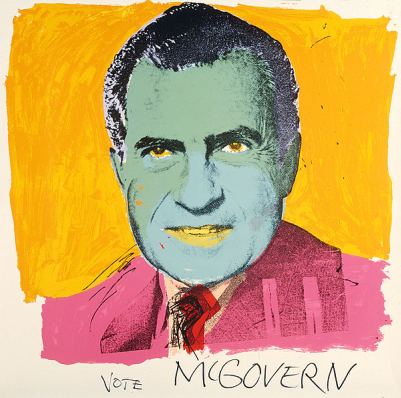 Other Warhol contributions: He gave interviews.
Other Warhol contributions: He gave interviews.2. Chris Jordan. From his most recent project, Midway: Message from the Gyre:
These photographs of albatross chicks were made on Midway Atoll, a tiny stretch of sand and coral near the middle of the North Pacific. The nesting babies are fed bellies-full of plastic by their parents, who soar out over the vast polluted ocean collecting what looks to them like food to bring back to their young. On this diet of human trash, every year tens of thousands of albatross chicks die on Midway from starvation, toxicity, and choking. To document this phenomenon as faithfully as possible, none of the plastic in any of these photographs was moved, placed, manipulated, arranged, or altered in any way. These images depict the untouched stomach contents of baby birds in one of the world's most remote marine sanctuaries, more than 2000 miles from the nearest continent.
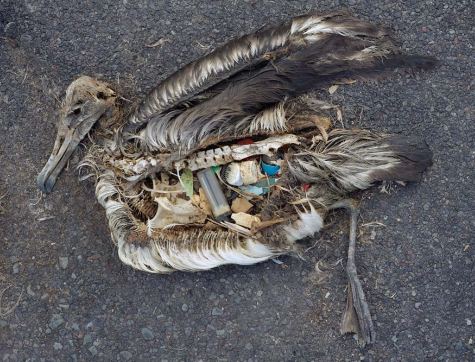 3. Jack Daws. Remember Florida's role in presidential politics, circa 2000? Daws tried to signal us in time to prevent a repeat in 2004.
3. Jack Daws. Remember Florida's role in presidential politics, circa 2000? Daws tried to signal us in time to prevent a repeat in 2004.SERFS UP! 2004 Chromogenic print of artist-made construction from sand from Florida photographed by Richard Nichol 32 x 40 inches, Edition of 5

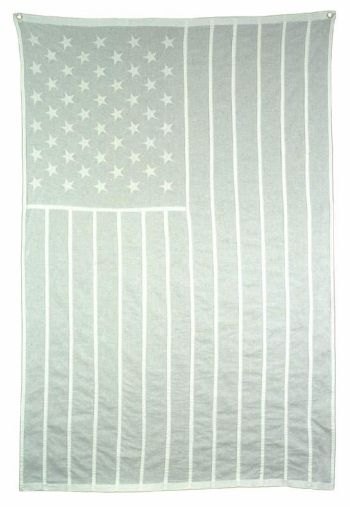 4. Sam Durant. Tell the truth. When it comes to history, an attempt to essay the thing that actually occurred is better than a make-nice Thanksgiving fable.
4. Sam Durant. Tell the truth. When it comes to history, an attempt to essay the thing that actually occurred is better than a make-nice Thanksgiving fable. 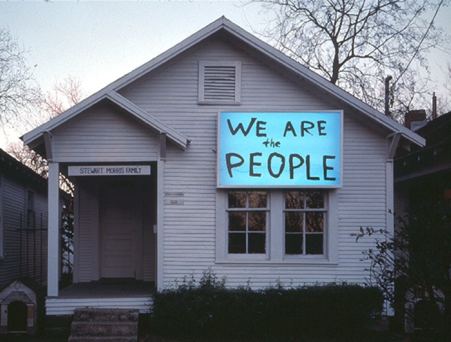 5. Grant Barnhart. Seeing ourselves as others see us, with rhythm. If this painting had a backup band, it would be Queen.
5. Grant Barnhart. Seeing ourselves as others see us, with rhythm. If this painting had a backup band, it would be Queen.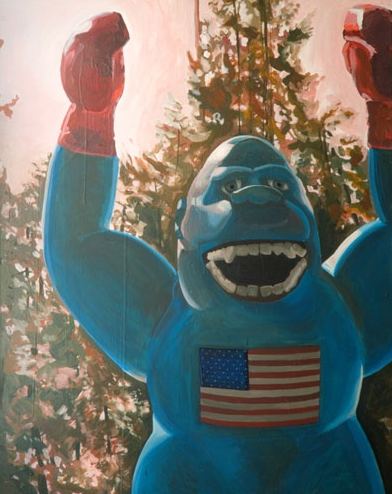
"Target Practice" focused on artists who saw painting as a closed world and attempted to pry it open. With single and multiple works by 40 talents from Europe, Japan, North America, and South America, it engaged what remains a fresh chaos of ragged representation and stands as the best contemporary-art survey in the museum's history.2. The Old Weird America: Folk Themes in Contemporary Art, curated by Toby Kamps for the Contemporary Arts Museum Houston, had its last stop at the Frye Art Museum and continues through Jan. 3. From my reviews on this blog:
Also terrific in this show are Jeremy Blake's cloudy mixtures of memory, guilt and loss; Matthew Day Jackson's post-Rauschenberg book of photographic imagery trailing across a wall like a diagrammed sentence, and Brad Kahlhamer's rush of signs and symbols hurtling across the paper like a river intent on a flood.3. Roger Shimomura at the Wing Luke Museum. From my review:
Dapper white boys and comely white girls enjoyed themselves in the comic-strip version of college life until the late '60s generation popped the bubble. In Frat Rats, Roger Shimomura painted the prelapsarian experience but added another icon dear to the hearts of the greatest generation: Racism.4. Dan Webb, Jeffry Mitchell, Claude Zervas and Joseph Park in From Whence the Rainbow Came at Ambach & Rice. From my review, Seattle's gang of four:
What is constructed, found and constructed again is the theme of From Whence The Rainbow Came at Ambach & Rice, featuring four of the Northwest's top artists: Claude Zervas, Joseph Park, Dan Webb and Jeffry Mitchell. It's the best group show in a Seattle gallery in years, proposed and shaped by the artists themselves.5. Heide Hinrichs and Debra Baxter at Howard House (also, Hinrichs at the Seattle Art Museum)
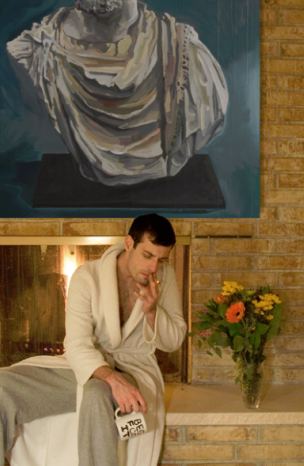 In spite of its self-mocking arrogance, his
pose is a comic acknowledgment of reality: He is a young painter
in Seattle at the edge of even the Seattle experience, overlooked as a
matter of course. With this image, he tells not only his nearly nonexistent audience but the wider world that it
will have to work to keep up with him.
In spite of its self-mocking arrogance, his
pose is a comic acknowledgment of reality: He is a young painter
in Seattle at the edge of even the Seattle experience, overlooked as a
matter of course. With this image, he tells not only his nearly nonexistent audience but the wider world that it
will have to work to keep up with him.Which is true. Those who know him expect attitude, and yet his paintings are all heart.
The old horse whose ragged breath congests in a clotted stream is wrapped in the consolations of color, fall trees behind her and flowers at her feet. Blooms surge as she recedes. For all her weight, she's drifting like a hair or a feather on a cloudy mixture of memory.
Killing Time With Sleeping Pills, 2009, acrylic/canvas, 36 x 48
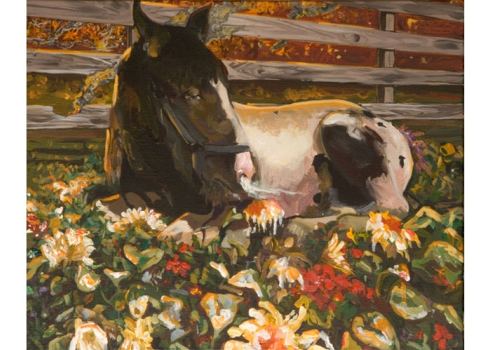 Sympathy for the devil: A killing machine leans its hammer head on a pier to die as gulls scream overhead.
Sympathy for the devil: A killing machine leans its hammer head on a pier to die as gulls scream overhead. Private Thoughts Are Lost, 2009, acrylic/canvas, 18 x 24
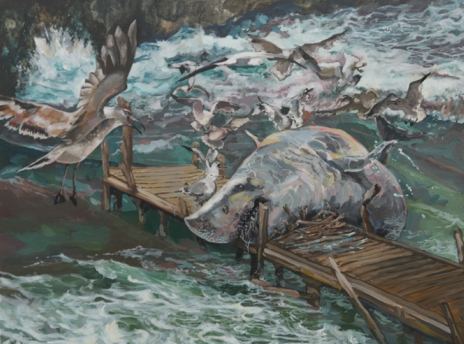 Foam and froth and dirty wings are all that's left of the deep, but the light that shimmers on the beast's bloated flank is as dainty as a Fragonard slipper.
Foam and froth and dirty wings are all that's left of the deep, but the light that shimmers on the beast's bloated flank is as dainty as a Fragonard slipper.Stephen Crane:
A man said to the universe:Thanks to scale shifts, now and then are together again in Goya garb and contemporary: The crowd marinating in its own stupidity gazes at a scene beyond its understanding.
"Sir I exist!"
"However," replied the universe,
"The fact has not created in me
A sense of obligation."
Mastiff On Trial, 2009, acrylic/canvas, 36 x 48
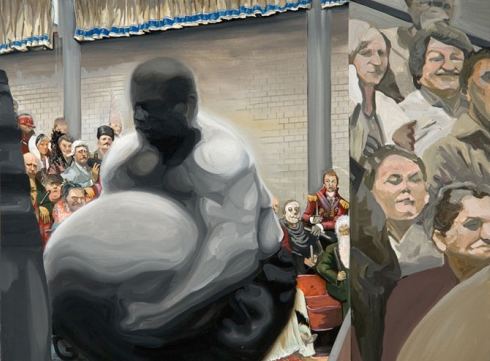 Sweeney Todd:
Sweeney Todd: On a lighter note: The image of women stepping into their underwear is an erotic staple, especially in Barnhart's vein of catching the subject unawares.
There's a hole in the world like a great black pit
and the vermin of the world inhabit it
And its morals aren't worth what a pig could spit...
Precious Broken Elastic, 2009, acrylic/canvas, 11 x 14 inches
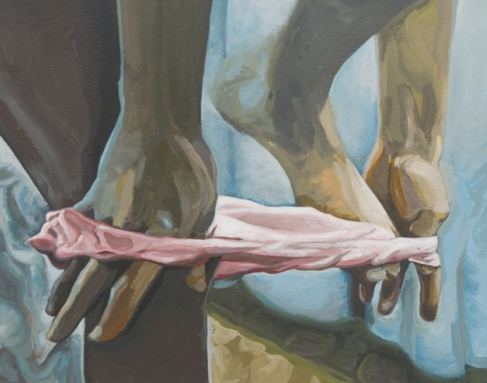 But pearly pink and baby blue shades set up a dainty scene that isn't there. If the model knows how to put on underwear, it's not evident from the image. She's forcing herself into her clothes like a plow furrowing a field.
But pearly pink and baby blue shades set up a dainty scene that isn't there. If the model knows how to put on underwear, it's not evident from the image. She's forcing herself into her clothes like a plow furrowing a field. Sunset, 2009, acrylic/canvas, 40 x 30
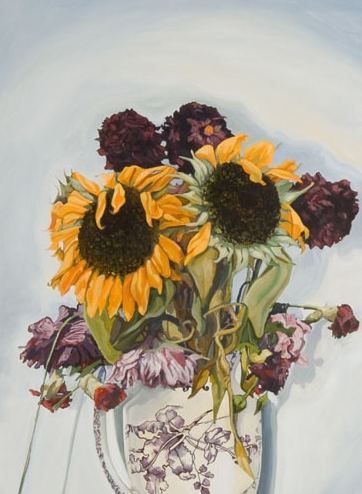 Isle of Man, 2009, acrylic/canvas, 60 x 48
Isle of Man, 2009, acrylic/canvas, 60 x 48 Although there are narratives here in an Eric Fischl vein, Barnhart isn't interested in creating a common thread. Fischl would never put such a range of paintings together in one show. He hits a theme and explores it. Barnhart's disregard for connectives approaches Martin Kippenberger's. Barnhart believes in the vibrational field of a painting, and the idea that vibrations on the same frequency tend to fuse. His do. Beg For It at Ambach & Rice is a force field. (My review of his previous show here.)
Although there are narratives here in an Eric Fischl vein, Barnhart isn't interested in creating a common thread. Fischl would never put such a range of paintings together in one show. He hits a theme and explores it. Barnhart's disregard for connectives approaches Martin Kippenberger's. Barnhart believes in the vibrational field of a painting, and the idea that vibrations on the same frequency tend to fuse. His do. Beg For It at Ambach & Rice is a force field. (My review of his previous show here.)Through Jan. 24.
Carrillo:
These are positives on glass plates also called Ambrotypes and they are 7 x 9 inches. Collodion is poured onto a glass plate then sensitized in silver nitrate then exposed while the plate is still wet- hence the name. When developed they have an antiquated, quirky, unpredictable, handmade quality to them that has made them irresistible and has, for me, brought the magic back of photography.Carrillo's portrait of the otherwise animate Steven Miller:
Neglected abstract geometric artists are plentiful? Are you talking about painters who deserve to be well known? Name five. Not just anybody, but somebody who has created work that could stand up to international attention. The artists at the top aren't there by luck. They are better than the obscure. I've never heard of Mary Henry. Her work looks pretty good online, but online is nowhere as you must know. There must be a reason why it doesn't fly when seen in person. If not, it would have.Ordinarily, I don't single out comments from someone who chooses to be anonymous, but I like this issue, if only because the idea that there are only three or four artists who matter in a generation is gaining ground. (The Onion's disquisition on the theme here.)
Jerry Saltz, lamenting it:
... instead of the love spreading and everyone becoming "famous for 15 minutes," by decade's end art-worlders fixated on a tiny clique of mostly male, mostly high-priced artists: Murakami, Hirst, Eliasson. Warhol's dictum was infernally inverted to "In the future, only 15 people will be famous."You don't need a weatherman to know that some people don't like to go outside. Anybody who believes a handful of artists represents the world doesn't care about art. If a focus is narrow enough, the only thing visible through its aperture is hierarchy. Art is about invention, possibility, rigor and surprise. Artists who rise to the top have all that and something else besides: the luck of the draw. For their representations of their place and time, they manage to become visible, frequently due to circumstances beyond their arranging.
My favorite fall-into-fame story is Charles LeDray's, which I've told before, here. To recap: He was born in Seattle in 1960 and raised here. His mother taught him to sew at age 4. By the time he was 10, he could sew, knit and macrame with a skill that staggered his elders. He took at the craft classes he could at the Queen Anne Community Center and endured the sexual taunting frequently hurled at boys who'd rather sew than play hoops or hang out at arcades.
LeDray, Grey Area, 2009
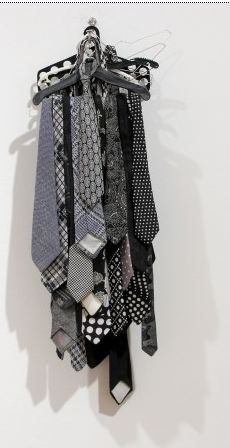 After high school, he took a couple of painting classes at Cornish College of the Arts but didn't complete them. He worked as a guard at the Seattle Art Museum in the mid-to late '80s and had a single exhibit of paintings at the Broadway Espresso in 1983. That's it, aside from the time he tried to show tiny figurative collages on the sidewalk during Pioneer Square's First Thursday Gallery Walk. The police, seeing gay porn, told him to pack up and leave. If anyone else noticed, there is no record of it.
After high school, he took a couple of painting classes at Cornish College of the Arts but didn't complete them. He worked as a guard at the Seattle Art Museum in the mid-to late '80s and had a single exhibit of paintings at the Broadway Espresso in 1983. That's it, aside from the time he tried to show tiny figurative collages on the sidewalk during Pioneer Square's First Thursday Gallery Walk. The police, seeing gay porn, told him to pack up and leave. If anyone else noticed, there is no record of it.The silence surrounding him in Seattle was resounding. In 1989, planning to try his luck in New York, he asked SAM's director of exhibition design, Michael McCafferty, to write a recommendation. Bear in mind that LeDray was a guard, not even a part-time member of McCafferty's design crew. Nevertheless, McCafferty whipped out a piece of museum stationery on which he scribbled a note to the effect that LeDray was a valuable member of his team and recommended him unreservedly.
After dropping his duffels at a friend's apartment, LeDray headed over to the Museum of Modern Art, where he presented McCafferty's introduction. That afternoon, he was handling MOMA's Van Gogh's.
When, years later, I asked McCafferty about this incident, I wondered if he sensed LeDray's latent potential. Did he think LeDray had the makings of a major artist, in other words? No, said McCafferty. Back then, I thought of him mainly as a collector of Space Needle memorabilia. McCafferty believes in recommending people. They ask, he says yes.
Back to LeDray. The freelance job at MOMA led to a job as art handler at the Jack Tilton Gallery. One day he noticed the objects in an upcoming exhibit had a link with what he made on his own at home to relax. Gallery director Janine Cirincione told him to show her. He brought in a bear in a jacket. She told him she couldn't use the bear but the jacket would do nicely. Hours before the show opened, she added LeDray, whose career took off.
Obviously, he had to be remarkable to turn McCafferty's blind recommendation into a career, and LeDray is. He's now a leader in what could be called the "Revenge of the Maker" movement, a corrective to the equally valid Call-It-In School. Without a series of fortunate accidents, however, would he have had the opportunity to be heard or would he have been the fabled tree whose fall in a forest attracted no witnesses and therefore made no sound?
Not Buying It asked for five artists who have worked in the abstract geometric vein and deserve a wider audience.
Simpson:
This collective effort provides a passage for undergraduates, serve as a civic effort to save maintenance costs, protects the campus environment from salt and abrasive sand and suggests a mental and physical college credit. Stay off the machines, keep shoveling, peace on earth.
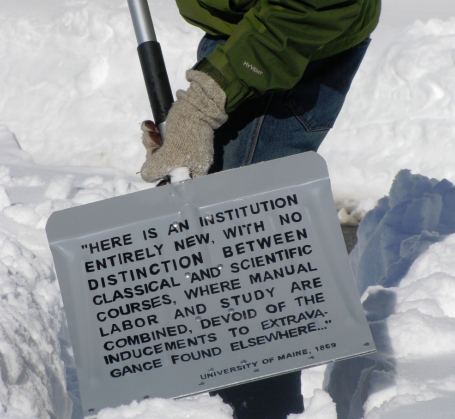
The Observer of London called Ms. Herrera the discovery of the decade, asking, "How can we have missed these beautiful compositions?"It's easy. Artists who would shine if those in charge of a significant stage managed to notice them exist all over the world. The interesting question is not why she was overlooked but why she's being noticed now. Turns out, the factors that held her back - being female, an immigrant and a practitioner of a style that was not in style - are the same ones working in her favor at this late date, when there's a serious focus on both Latin American female artists and Herrera's particular niche, geometric abstraction.
When it comes to geometric abstraction rooted in the early 20th century, neglected artists are thick on the ground. An obvious candidate for more attention is Seattle's Mary Henry, who died in May at age 96.
From my obit:
For her, abstraction was a clarifying order of interlocking rectangles, horizontal stripes, lumbering squares and powerful wedges. Her color choices leaned toward the bracing. Yellows tunnel through whites and hang over orange. Her blacks shine, and her blues areField of Silence, 1990 Acrylic on canvas, 72 x 60 inches.
deep as the sea.
 Baden Baden, 2002, acrylic on canvas, 24 x 24 inches
Baden Baden, 2002, acrylic on canvas, 24 x 24 inches Seattle writers who, like myself, were unable to interest the wider world in her work include Matthew Kangas, Jen Graves, Gary Faigin and Elizabeth Bryant, the latter not linkable online.
Seattle writers who, like myself, were unable to interest the wider world in her work include Matthew Kangas, Jen Graves, Gary Faigin and Elizabeth Bryant, the latter not linkable online. Graves:
Henry's paintings are alluring and unyielding, and I figure she's the only way into them.Fortunately, that's not true. Henry's gone but her paintings are still here, available for viewing at Howard House, which has a goofy Web site. You have to follow the links to get to her. The paintings, not the artist who made them, offer the best route into themselves.
No humor allowed: Jen Graves posted this dazzling piece of (at least brief) nonsense yesterday:Surely the man who invented the place where all the women are strong, the men are good looking and the children are above average would have to be kidding when he sounds like a sexist troll.Remember: American men don't do art unless it involves naked ladies, unless the men have thin shoulders. I hate you, Garrison Keillor.Jen. He's kidding. Kidding. The whole thing is a spoof on sex stereotypes, not an indulgence of them. Hate Garrison Keillor? Save it for Dick Cheney.
Maybe not. Seattle painter Susanna Bluhm referred me to another version of what's on Keillor's mind these days. Turns out, he's mad at musical Jews.
And all those lousy holiday songs by Jewish guys that trash up the malls every year, Rudolph and the chestnuts and the rest of that dreck. Did one of our guys write 'Grab your loafers, come along if you wanna, and we'll blow that shofar for Rosh Hashanah'? No, we didn't. Christmas is a Christian holiday--if you're not in the club, then buzz off. (more)
What's up with Keillor? The doctor is not in, but I'm tempted to think the aging humorist has a medical problem. Something pressing on his cerebral cortex, perhaps? Shout out to Keillor: Time for a check up from the neck up.
Second apology goes out to Stranger book critic Paul Constant. When the Los Angeles Times covered the Elliott Bay Book Company's closure in Pioneer Square, I praised the article, saying the locals missed the story under their noses. I singled out Constant for special blame, saying he was "more interested in griping that he didn't get full credit from the Seattle Times for being first as the news breaker." (more)
The problem is, the LA Times piece read a bit like an obit. Yes, Elliott Bay is leaving Pioneer Square, which is a huge blow to the neighborhood, but, as Constant later reported, it is reopening on Capitol Hill. Constant was waiting to get his facts straight, always laudable.
In the immortal words of Gilda Radner:
From Neil Goldberg's video, My Parents Read Dreams I've Had About Them, 1998. (He told them not to smile.)
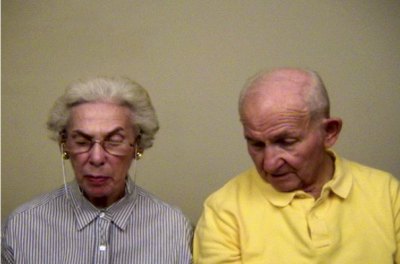 Also ending Saturday:
Also ending Saturday: 
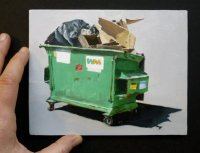 If you squint, it's almost a tree.
If you squint, it's almost a tree.Yeats:
Ashbery:That is no country for old men. The young
In one another's arms, birds in the trees
---Those dying generations---at their song,
The salmon-falls, the mackerel-crowded seas,
Fish, flesh, or fowl commend all summer long
Whatever is begotten, born, and dies.
Caught in that sensual music all neglect
Monuments of unageing intellect.
Today they are as abundant as mackerel, as far as the eye can see,
tumbled, tumescent, tinted all the colors of the rainbow
though not in the same order,
a swelling, scumbled mass, rife with incident
and generally immune to sorrow.
Shall we gather at the river? On second thought, let's not.
In Ashbery's honor, a small survey of the art of disgust. Shall we gather at the river? On second thought, let's not.
Marc Quinn, SELF (red), 2006
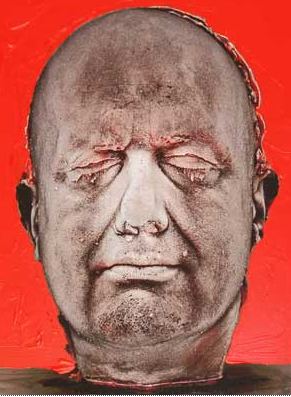 Katy Stone, Explosion 7 (double bloom), 2006
Acrylic on Duralar, pins
Katy Stone, Explosion 7 (double bloom), 2006
Acrylic on Duralar, pins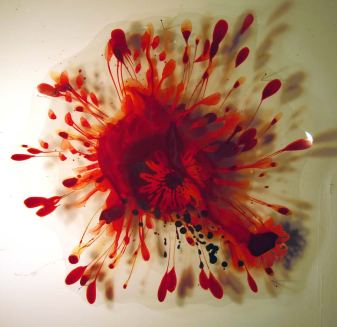 Grant Barnhart, 1938 Acrylic on canvas, 2009
Grant Barnhart, 1938 Acrylic on canvas, 2009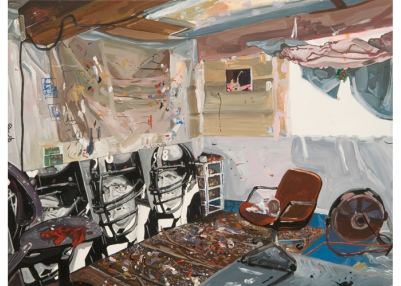 Jon Haddock R.King - Screenshot Series
2000
chromogenic print from digital file created in photoshop
Jon Haddock R.King - Screenshot Series
2000
chromogenic print from digital file created in photoshop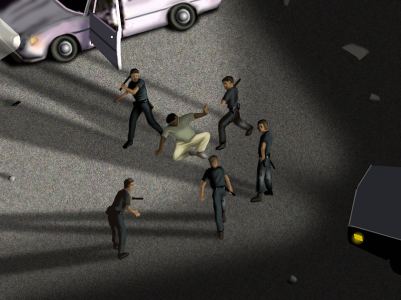 Nigel Cooke, Mind, 2008 Oil/Canvas
Nigel Cooke, Mind, 2008 Oil/Canvas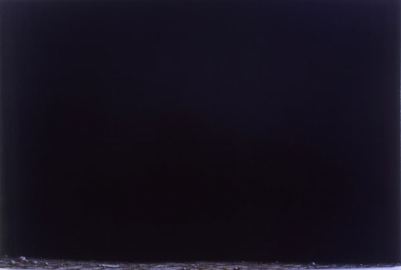
Richard Wright won the Turner Prize. It didn't hurt him that he frequently destroys what he makes, which means like traditional sand painting, that work is unavailable for purchase. Because nobody's in it for the money, everybody shares in the warm glow of the moment. Self-editing blue chips can get by on grants, patronage and prizes, as well as what they don't toss.
What about artists of whom few have heard? When they make a habit of destroying their product, few care because few know.
Let me introduce Seattle's Randy Wood. When he wants to, which isn't often, he can paint images of rocks and trees that the amateurs of the Chinese literati tradition would have viewed with favor. Possibly as a homage to them, all of course dead, he sends the drawings crafted in their style to join them: dust thou art, or, in the case of one performance, bedding thou art.
At Soil in 2005, he presented a long glass case with drawings fanned out along the bottom and two rodents scurrying back and forth on top of them. During the course of the exhibit, the rodents chewed the drawings to pulp, which they used as bedding.
First day of They Will Be The Judge Of That:
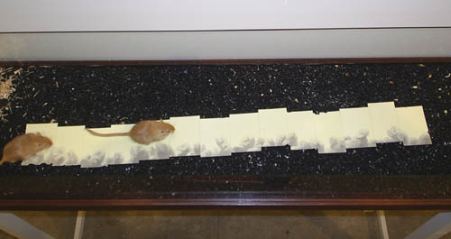 Wood occasionally takes to the road with a performance he calls Bye Bye Little Drawing.
Wood occasionally takes to the road with a performance he calls Bye Bye Little Drawing.From his Web site:
It consists of myself sitting at a portable table, creating watercolors and ink drawings and, as soon as they dry, running them through a paper shredder. People have strong reactions to the shredding of my own work. I've been asked to stop, some have offered to buy a piece before I destroy it, and children love to watch art get shredded.
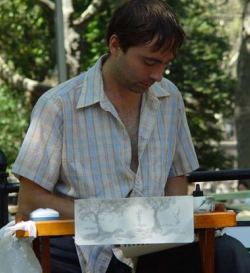
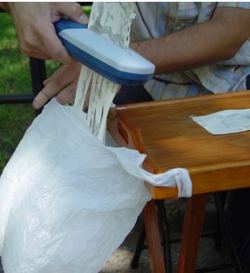 I once asked if he'd save from the shredder a single line of trees whose leaves were a furry green. Like the man who wouldn't help The Band find a place to lay their heads, no was all he said.
I once asked if he'd save from the shredder a single line of trees whose leaves were a furry green. Like the man who wouldn't help The Band find a place to lay their heads, no was all he said.Highlights.
Xue Song, Coca Cola, 1998, 24 x 20 inches.
 Miwa Yanagi, Yuka, from the My Grandmothers series, 2000. Chromogenic print on Plexiglas, mounted on aluminum.
Miwa Yanagi, Yuka, from the My Grandmothers series, 2000. Chromogenic print on Plexiglas, mounted on aluminum.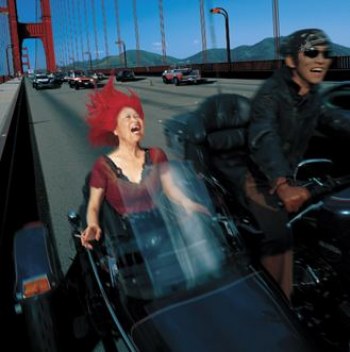
 Chiho Aoshima, Red Eyed Tribe Maker, 2002, print
Chiho Aoshima, Red Eyed Tribe Maker, 2002, printYuken Teruya, Untitled, (Sigonas), 2002, paper bag sculpture
Joseph Park, Tigerish Bean Maker, 2005, painting
Johsel Namkung, four photographs, 1980s, including:
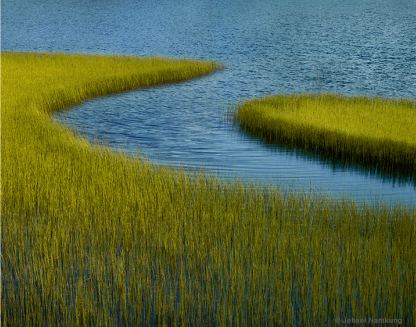 Wei Letang (John Way), hanging scroll, 1988
Wei Letang (John Way), hanging scroll, 1988Mr. Hikone Maker, two paintings, 1999-2000
Shen Shichong, hanging scroll, 1629
Zhang Yu, hanging scroll, 1792
Toshiko Takaezu, late 1950s stoneware.
 Koo Bohnchang , vessel, 2005
Koo Bohnchang , vessel, 2005Deng Shu, Boating in Guangling, 1924
Sarah Sze, scroll, 1996
Aki Fujimoto, Mmmmmmmmmmmm 1999; Fine Today, 1999, and 9 Polaroid prints, 1999
Tomoko Takahashi, Line In & Out: Day and Night, 1999
Shen Liang, Book Cover Series, 2006
Sun Yi, hanging scroll, Peony Maker, early 18th century
Hiroshi Sugimoto, Sumiyoshi House, photograph, 1999
Bada Shanren (Zhu Da), hanging scroll, Lotus and Ducks Maker Bada Shanren, 1690s
Akio Takamori, Sleeper, Maker, 2000
John Schuh
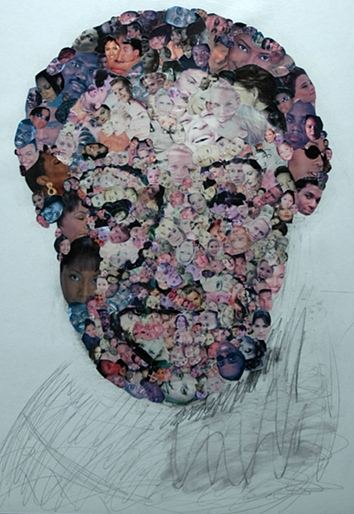 William Powhida (click image to enlarge)
William Powhida (click image to enlarge)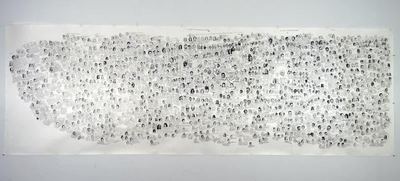 The Powhida drawing is part of his contribution to a group show at Platform Gallery, The There, through Jan. 1.
The Powhida drawing is part of his contribution to a group show at Platform Gallery, The There, through Jan. 1.I hope to see Urs Fischer at the New Museum but haven't yet. Has Schjeldahl? He wrote his paragraph review to bury Fischer, not consider him. It's brilliant as writing but inert as criticism.
"Why must the show go on?" Noël Coward wondered. The question recurs apropos a desperately ingratiating Urs Fischer exhibition at the New Museum. Frail japes by the mildly talented Swiss-born sculptor--the international art world's chief gadfly wit since Maurizio Cattelan faded in the role--are jacked up to epic, flauntingly expensive scale. There are huge aluminum casts of tiny clay lumps (you can tell by the giant thumbprints), walls and a ceiling papered with photographs of themselves, and big mirrored blocks that bear images of common objects. When a hole in a wall is approached, a realistic tongue sticks out of it. A faux cake is suspended in the air by hidden magnets. It's all nicely diverting--but from what? If you spend more than twenty minutes with the three-floor extravaganza, you're loitering. The New Museum could just as well not have done the show while saying it did. The effect would be roughly the same: expressing a practically reptilian institutional craving for a new art star.Schjeldahl could be a broker glancing at stock results - who's up, who's down - or an insult comic, his quips his weapon. Almost any artist can be made to seem ridiculous by describing the work in this kind of seen-one, seen-all tone. Schjeldahl's real target is the New Museum. I love this phrase - "a practically reptilian institutional craving for a new art star" - but isn't it possible that a suspect platform can still deliver a real thing?
When Richard Avedon's In The American West came out in 1985, some said it traded in stereotypes. He photographed small timers wheeling in their own worlds like planets. They pumped gas or stuck up the station, stood on their feet all day behind a counter or sat in front of a TV set, failing to respond when paged by their charges in the welfare nursing home.
Avedon:
 She's made of money from the petty cash drawer. What happens when this image is recast as embroidery?
She's made of money from the petty cash drawer. What happens when this image is recast as embroidery? Allison Manch:
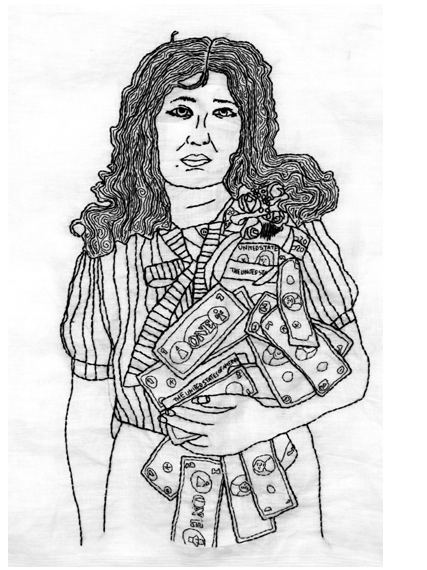 The act of sewing seeds a barren ground with domesticity. The figure is the same person in the same moment, but every inch of her has a achieved a homey acceptance. She's now a name written in her grandmother's Bible that no one ever crosses out.
The act of sewing seeds a barren ground with domesticity. The figure is the same person in the same moment, but every inch of her has a achieved a homey acceptance. She's now a name written in her grandmother's Bible that no one ever crosses out. Manch's Gimme Shelter is at Grey Gallery through Feb. 6.
Through a palazzo entry on the Via de' Bardi is the entry to the newly-opened Bardini Gardens. Right beyond the Via de' Bardi, which is one block across the Arno, the hills begin to rise up steeply to where the old fort is located at the back of the Boboli Gardens. The entire hillside - I'd guess 20 acres - is composed of formal and semi-formal gardens.
None of this has been open to the public - ever. It has been restored over five years or so and just opened within the last few months. Statues, fountains, rivulets, massive and mini stairways, plazas, and perches. Trees and other flora of every conceivable variety. Plus . . . and this is a stunning plus . . . closeup views of the whole city. The views are like being swept on a magic carpet from San Miniato al monte so close to the city that you feel you can reach out and touch the Duomo. The gardens are peaceful, beautiful, fanciful, stunning, thrilling, eccentric, and a joy.
From the back of the Bardini Gardens you can go down a short block and through a back gate into the Boboli Gardens. Liz and I truly loved the Bardini Gardens. Fortunately we forgot to bring our camera. We would have wasted our time trying to take thousands of pictures. As Ama's mother said, "Pictures not enough." You need to go there. "Web site not enough" either, and the Web site pictures don't approach what the eye sees, but there is a Web site.
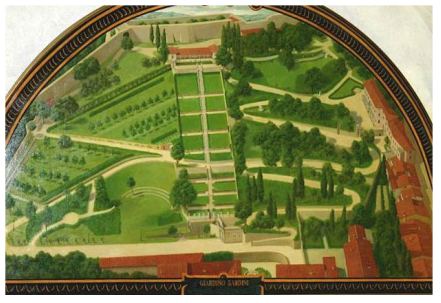
In the commonplace world, all new arts are trash. In Elizabethan times, it was commonplace to say that Shakespeare's theatre was trash. And then it was the novel's turn: the novel, they said, was trash. And then the film came along. First it was the silent film, and the commonplace was that it was trash -- until the sound film emerged. Then the silent film suddenly became an art, as the theatre and the novel had, and it was the sound movie that was trash. Today, all film is becoming art. What's trash today, then? Comics, of course. But now that the newspaper strip is ailing, the commonplace is that it may be art. Those comic book stories, though, they're surely trash...
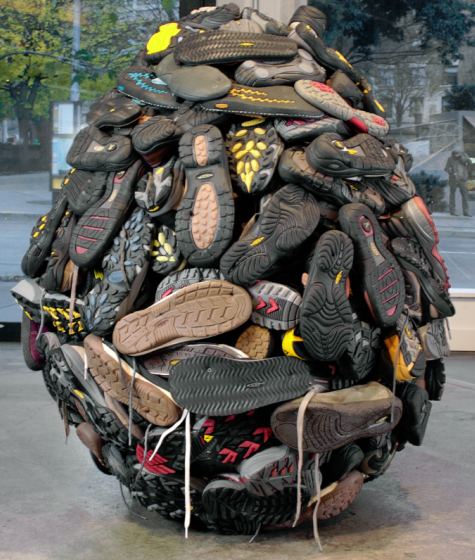 Brent Crothers
Brent Crothers 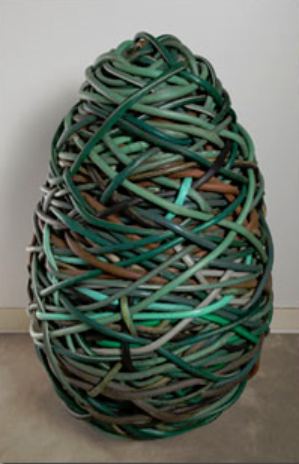 Crothers via C-Monster
Crothers via C-Monster  Anish Kapoor, what the right angle delivers, image via.
Anish Kapoor, what the right angle delivers, image via.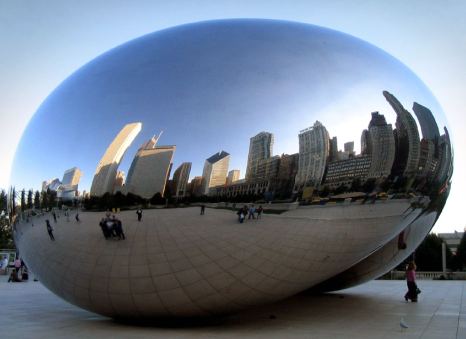 Jun Kaneko
Jun Kaneko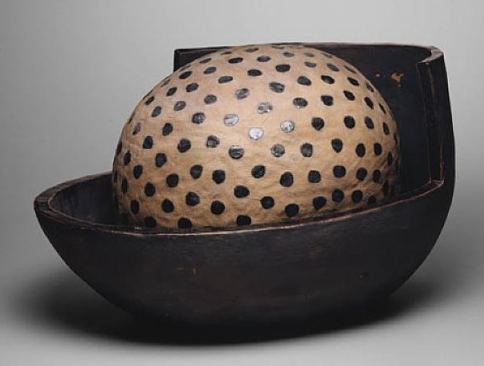 Max Nowell
Max Nowell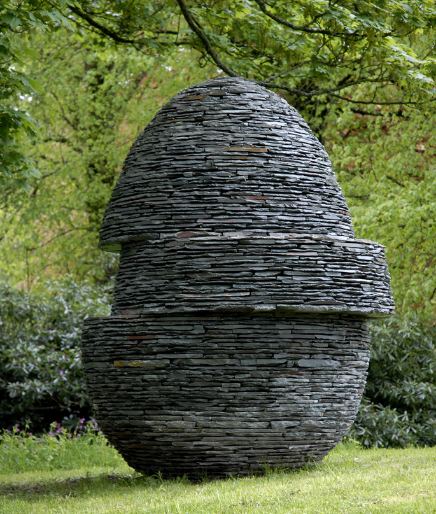 Egg Nest Via
Egg Nest Via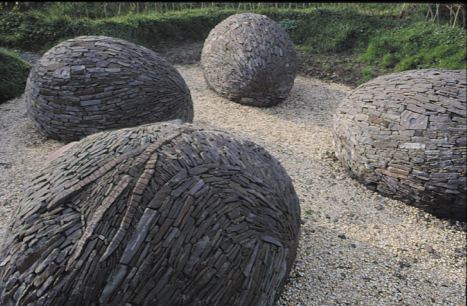 Egg Road (Arid)
Egg Road (Arid)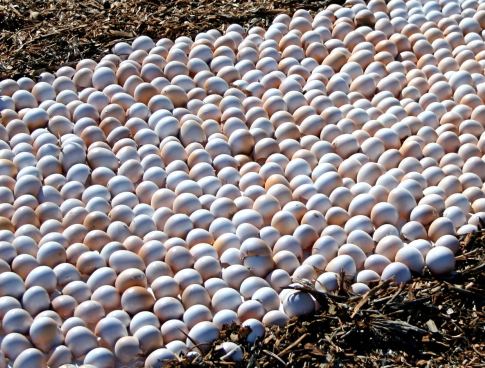 Gloria Bornstein
Gloria Bornstein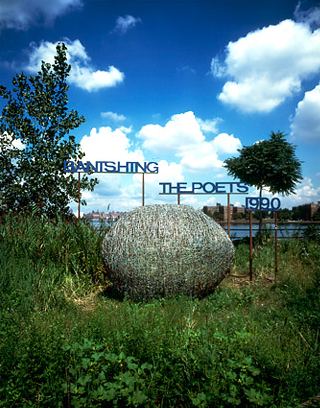 Hank Hofstra
Hank Hofstra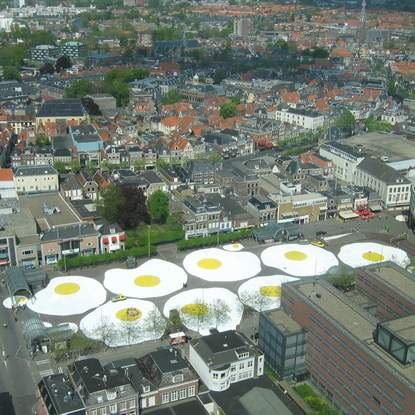 And early in the 20th century, the giants of the theme:
And early in the 20th century, the giants of the theme:Left to its own devices, the art establishment tends to contract around white males. Few curators want to admit to considering the issue when making their choices. It's much loftier to say they only think about art. Saltz helps them pause before finalizing unconscious prejudice into their lineups, even if they won't admit it.
Other news:
Tyler Green lets New Orleans Museum of Art E. John Bullard have the first word, interviewing him on why he decided to turn the museum over to Disney Studios. (Green followed the next day with his opinion, but I'm not sure he needed to. Bullard hung himself.)
Leah Ollman on Culture Monster sort of reviews an artist-selects series at Steve Turner Contemporary:
The series will draw from local private collections, with contemporary artists doing the choosing -- a nice variant on familiar curatorial practices but one that would be even better accompanied by a statement from the artist in charge.Ms. Ollman: The artist's statement is the work selected. Written commentary is your job.
The Houston Chronicle's indefatigable art critic, Douglas Britt, has taken a job as the paper's society writer. It's a real job, unlike his previous. Being the art critic meant he was under meager contract, one short step up from freelance. Here's what he wrote in the paper:
There I was, minding my own business as the Chronicle art writer, when my boss said, "You'd look good in a tux." (more)I'm happy he's getting a living wage at a daily newspaper and know he'll continue to write about art, although obviously not as frequently in the Chronicle.
Kenneth Baker reviews an exhibit based on Moby Dick. Sounds like the theme is a stretch for some of the participants. Rigor would have been easy to add if the curator had thought of Grant Barnhart. Barnhart's acrylic painting, Private Thoughts Are Lost, serves as a coda to the white whale's fate, even though the mammal depicted is not a whale. (It's not a pipe either.) The painting's soul is right out of Meville.
 Also, via This Isn't Happiness:
Also, via This Isn't Happiness: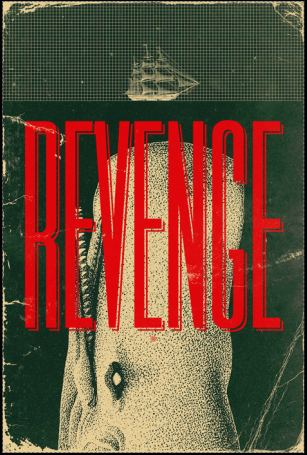
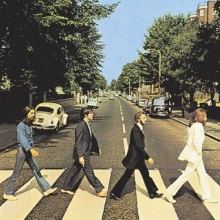 Abbey Road again:
Abbey Road again: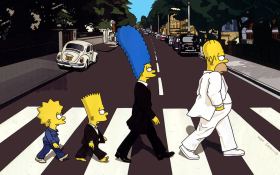 And again, from Joan Engelmeyer:
And again, from Joan Engelmeyer: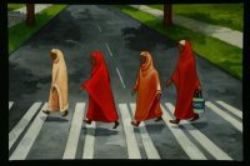 Engelmeyer's paintings are at Zeitgeist through December in an exhibit titled, From Here to There.
Engelmeyer's paintings are at Zeitgeist through December in an exhibit titled, From Here to There.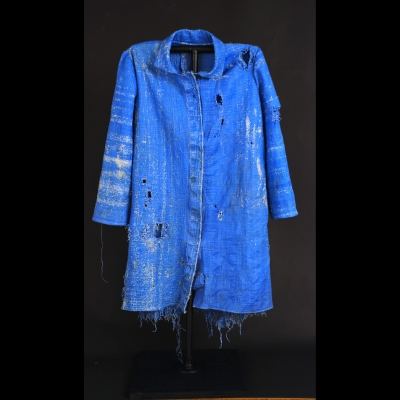 When my sister's husband refused to speak to her all night and into next morning for a trivial mistake, I suggested that next time he insisted on the silent treatment, she could pour honey in his work shoes. When he slipped them on in the morning, he'd talk. If not, she could cut up his favorite suit and leave it in shreds on its hanger.
When my sister's husband refused to speak to her all night and into next morning for a trivial mistake, I suggested that next time he insisted on the silent treatment, she could pour honey in his work shoes. When he slipped them on in the morning, he'd talk. If not, she could cut up his favorite suit and leave it in shreds on its hanger. Ruined clothes carry a message. They rebuke us for our rage and take up space in our heads long after they're gone.
Eric Yahnker, Analogous To The Fall Of That One Empire (Gap Shirt) 2004-2005 Shirt in which all of the thread has been removed excluding the pinstripe pattern.
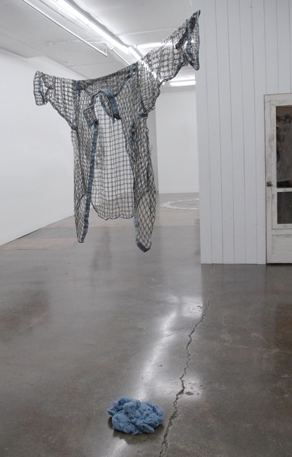 Peter Shelton's whitecoat is not an empty husk. It stands on its own, having squeezed whoever wore it out of the picture.
Peter Shelton's whitecoat is not an empty husk. It stands on its own, having squeezed whoever wore it out of the picture. 
The Rajneesh were pioneers of the antiseptic erotic. They favored frolic but feared additions to their bacterial count. Anyone aspiring to an evening of bliss had to agree to wear the gloves. Thirty years later, Elizabeth Jameson creates art that could be said to be made in their image. She too tends to favor shades of the rising sun, and she too imagines a world in which absurd safeguards to health are essential.
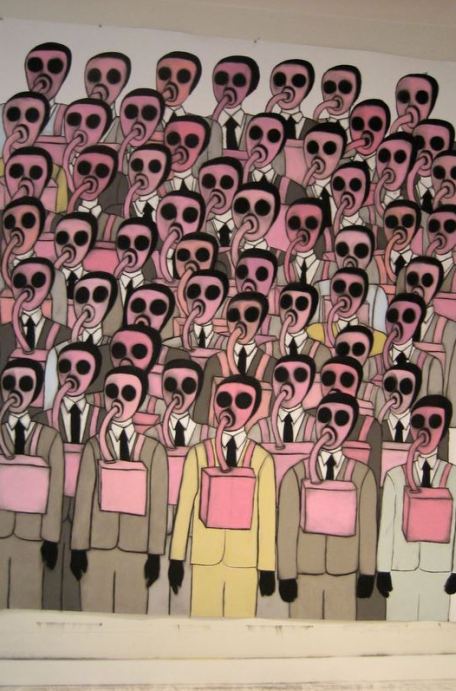 In that world, the air you breath is out to get you. Isolation wraps each figure, even when they're holding hands.
In that world, the air you breath is out to get you. Isolation wraps each figure, even when they're holding hands.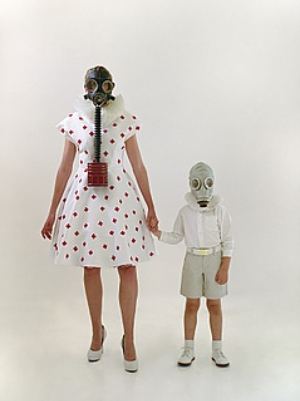 No one mourns or appears to notice anything out of the ordinary in their downward evolutionary spiral, from the human to a space-age insect realm.
No one mourns or appears to notice anything out of the ordinary in their downward evolutionary spiral, from the human to a space-age insect realm.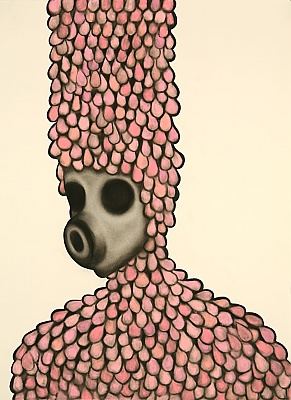 In 1968, Philip Dick asked, Do Androids Dream of Electric Sheep? What are the dreams of Jameson's women? Silks made of rose petals and of blood, as distant as the North Star.
In 1968, Philip Dick asked, Do Androids Dream of Electric Sheep? What are the dreams of Jameson's women? Silks made of rose petals and of blood, as distant as the North Star.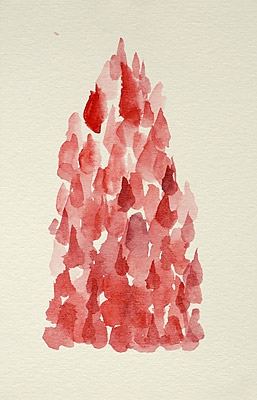
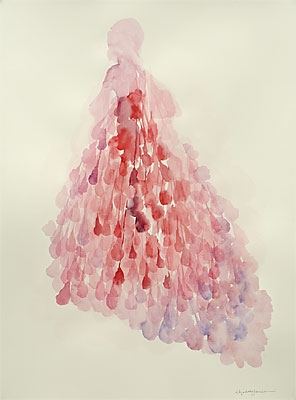 At Fetherston Gallery through Dec. 19
At Fetherston Gallery through Dec. 19"Out," she said.
"Come on, lady," he said.
"You have to leave," she told him. "Do I go into your home and dry hump your cyclops?"
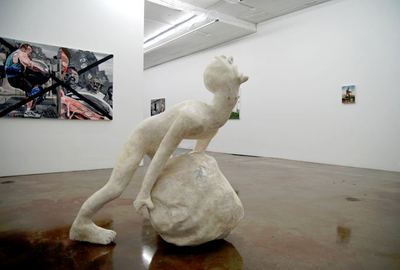 They left. Barnhart's Beg For It continues through Jan. 24. Review to follow.
They left. Barnhart's Beg For It continues through Jan. 24. Review to follow.Through the moving windows of the tram I view this month's art installation: foil-propellers stuck to the walls of the tunnel. Hundreds of them. They shiver and whirl as the trains gain speed past them. How much was the artist paid for this? Who paid him? Is this where the airport's per-ticket surcharge goes? Last month's masterpiece was a row of masks with progressively wider mouths and eyes that seemed to open as the viewer rode by, climaxing in a howl, a staring scream.In time for the holidays, Kirn's sky-high hero of therapeutic capitalism has hit the screen in the body of George Clooney.
Art. It always makes me feel diminished. There's something smug about it. Cocky, cold. Public works commissioners just love this stuff. It eases their bad consciousnesses, I suspect, for hiring their nephews and steaming open sealed bids. Behind every sculpture garden, a great crime.

Cotter, husband, army, 2009.
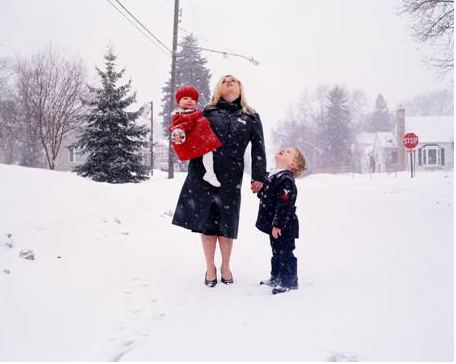 Fullerton is part of a members exhibition at Photographic Center Northwest curated by Western Bridge's Eric Fredericksen, reception tonight, 6-9.
Fullerton is part of a members exhibition at Photographic Center Northwest curated by Western Bridge's Eric Fredericksen, reception tonight, 6-9. Tharp
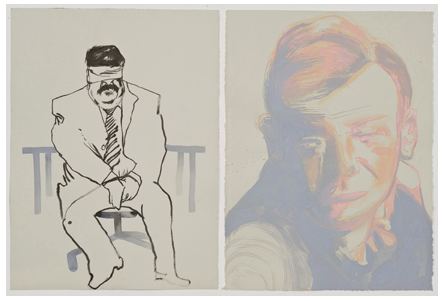 Jessica Jackson Hutchins
Jessica Jackson Hutchins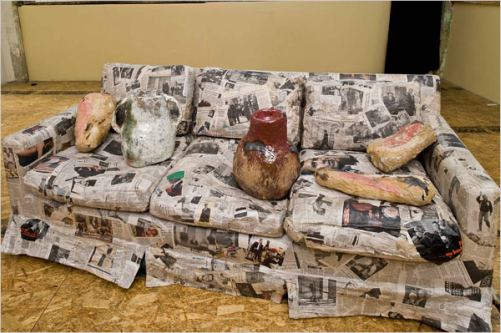
He died today at age 78. (Randy Kennedy obit here.)
He invented the blockbuster but was most proud of his ability to spot a fake. He'd freely admit that he sympathized more with forgers than with the collectors and museum professionals they fooled. In False Impressions: The Hunt for Big Time Art Fakes, he wrote about a favorite, Frank X. Kelly, whom Hoving met while an undergraduate. A painting restorer, Kelly played the horses, knew baseball like the beating of his own heart, smoked constantly, ate badly and made art fakes.
Hoving found some unfinished Monets in the stacks and confronted him. The old man promised to teach Hoving his trade secrets if the young man kept quiet. Hoving learned that a good fake looks juicier, more appealing, than the original. The surface only mattered, as deeper analysis produced conflicting information. Cooking up a complicated provenance for the piece was unnecessary and often made the deal more suspicious.
On tour for the book in Seattle, he took care to be quotable. Choice samples from a 1996 interview here.On museum directors:
They're muddled progressives, staunch conservatives or the petrified. Especially the petrified. I don't think they have any idea what they're doing. I was director (at the Met) from 1967 to 1978. That's too long. Directors should get out after seven years. After that, they're either too tired or too gutless to do the job.
On fakes:
Everybody wants to believe they'll find a Ming vase at a flea market, pay $1.89 for it and sell it for $1 million. There are serious collectors who've fallen for Degas pastels painted in oils. They can't tell. And when they find out, they cover it up.
On his contribution:
I'm a popularizer. I opened the place up. I wanted to see John Travolta pick up girls on the steps of the Met. I tried to make the Met a subway stop. I was the first to hang big banners outside. Our audience was old and the audience at the Museum of Modern Art was young. I wanted to steal Modern's audience.Here's a 2008 video of Hoving lavishing praise on Dale Chihuly.
Born in Germany and currently living in Seattle, she is the subject of a solo exhibit curated by Marisa Sanchez at the Seattle Art Museum, part of a series titled SAM NEXT, whose focus is alternatively regional and international.
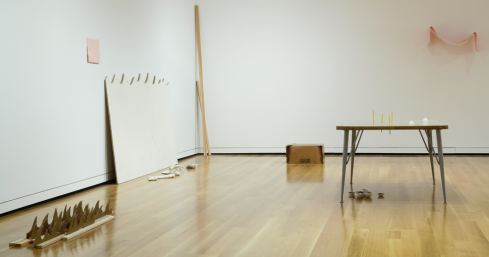 The objects in this show, both found and fabricated, collectively create a kind of landscape. There is solace in its silence, a quiet that enfolded the viewer who walks inside it. A few weeks ago, I saw a small group of rowdy middle-schoolers enter and respond, their hush a tribute.
The objects in this show, both found and fabricated, collectively create a kind of landscape. There is solace in its silence, a quiet that enfolded the viewer who walks inside it. A few weeks ago, I saw a small group of rowdy middle-schoolers enter and respond, their hush a tribute. Through June 13.
Jesse Bernstein:
I sneak a cream of wheat sandwich and stale sweet roll, wash it down with juice squeezed from a leather belt.
For the fast food crowd who can overlook an indictment as long as it comes with ketchup, there's Jack Daws' memorial for the World Trade Center.
TWO TOWERS, 2003 Chromogenic print of artist-made construction from McDonald's French fries and Heinz ketchup photographed by Richard Nichol 50 x 40 inches, Ed/10
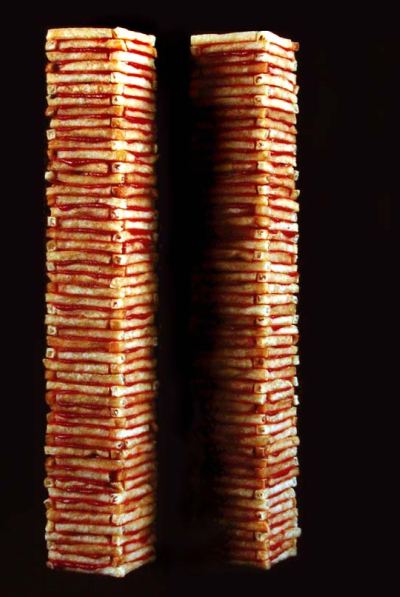 For those whose culinary standards are a little higher, Dan Webb provides a Feast.
For those whose culinary standards are a little higher, Dan Webb provides a Feast.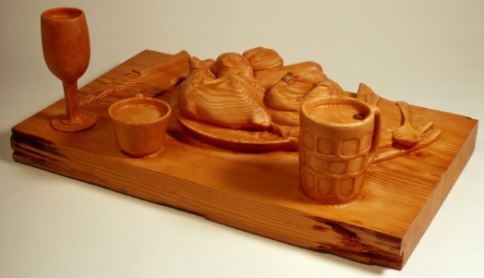 For dessert, Greely Myatt has the cake. (More on Myatt from Nicole Griffin on SOAP.)
For dessert, Greely Myatt has the cake. (More on Myatt from Nicole Griffin on SOAP.)
Containing chips of Western red cedar, soil from Port Madison and brick fragments from Ted Bundy's childhood home, it's a $600 portrait of small town noir. Who wouldn't want a little Ted Bundy for the holidays?
 Zoe Strauss had a similar take on Tacoma when she was in town.
Zoe Strauss had a similar take on Tacoma when she was in town.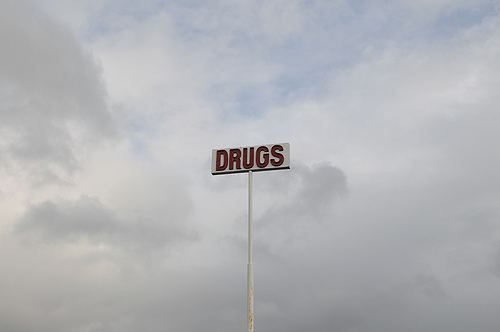 The recession has been a long dry run. Note to those who are flush: Time to support a gallery or two.
The recession has been a long dry run. Note to those who are flush: Time to support a gallery or two.Wiley's Slant Step from 1966 bears this inscription:
this piece is dedicated to all the despised unknown unloved people objects ideas that just don't make it and never will, who have so thoughtlessly given their time and talent to become objects of scorn but maintain an innocent ignorance and never realize that you hate them.
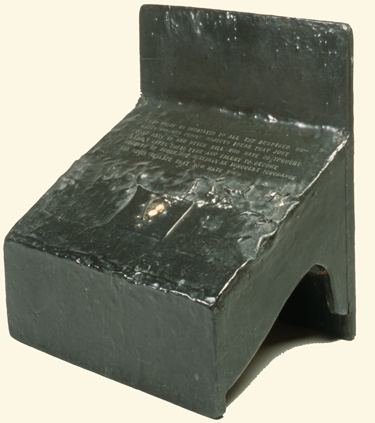
Dividing his time between Montana and Hawaii, he favors a fast-growing white wood found in Hawaii and known as Malaysian jelutong. Similar to cottonwood, jelutong is soft and pliant. Each of Buck's rough, chisel cuts eats into the wood and creates small ripples of disturbance across the surface. No matter how precise and detailed his carving becomes, it's never fussy or anonymous. Evidence of the artist's hand is always there, recorded in ragged little stabs.
A survey of his prints
Aside from carving, woodcuts are Buck's strong suit, well represented here. The boldly articulated central figures are surrounded by knotted coils of representation that appear to derive from William T. Wiley. What is comic frenzy in Wiley becomes for Buck a crazy world sealed in a bottle and seen at an austere remove.
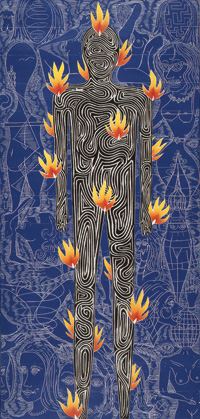
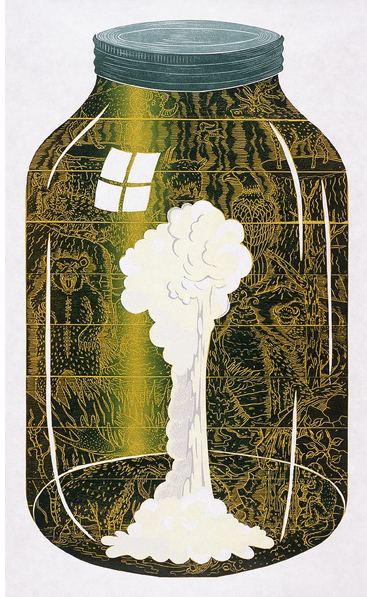
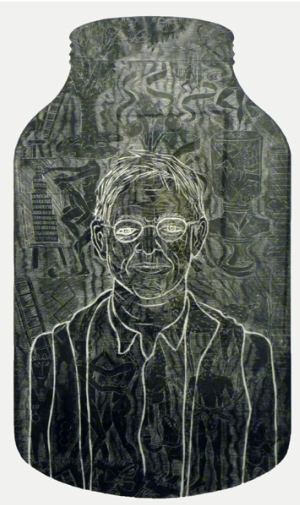 Through Feb. 28.
Through Feb. 28. Untitled, Clay and glaze, 1983
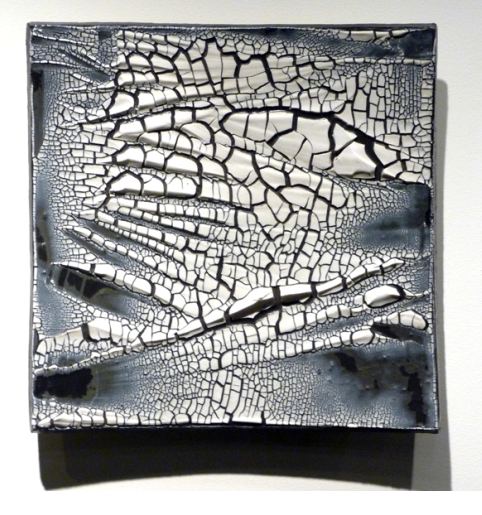 His retrospective, Bright Abyss, is at the Bellevue Arts Museum curated by Stefano Catalani and accompanied by a 270-page catalog with full color illustrations, written by Matthew Kangas. In light of the fact that catalogs are getting harder to find (the Seattle Art Museum's astonishing Calder show doesn't have one, for instance), BAM's commitment to full service is admirable.
His retrospective, Bright Abyss, is at the Bellevue Arts Museum curated by Stefano Catalani and accompanied by a 270-page catalog with full color illustrations, written by Matthew Kangas. In light of the fact that catalogs are getting harder to find (the Seattle Art Museum's astonishing Calder show doesn't have one, for instance), BAM's commitment to full service is admirable.Untitled, Stoneware with slip
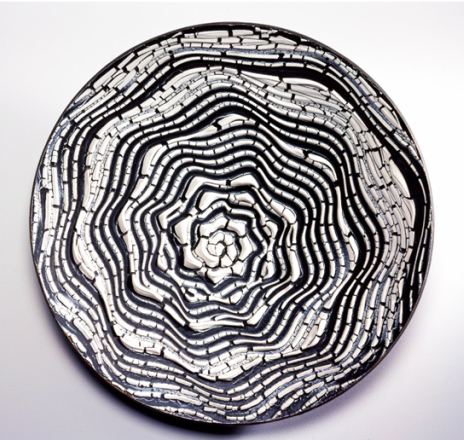 With Warashina and Howard
Kottler, Sperry created a ceramics department at the University of
Washington that captured nationwide recognition.
Big thanks to BAM for this show, even though it sits in the museum's dread second floor, curling out of dark galleries into dark hallways. The only adequate gallery spaces at BAM are on the third floor, currently housing an exhibit of John Buck's woodcuts. I would have reversed these shows, as woodcuts are harder to ruin. Just hang them up in a line and turn on the lights.
With Warashina and Howard
Kottler, Sperry created a ceramics department at the University of
Washington that captured nationwide recognition.
Big thanks to BAM for this show, even though it sits in the museum's dread second floor, curling out of dark galleries into dark hallways. The only adequate gallery spaces at BAM are on the third floor, currently housing an exhibit of John Buck's woodcuts. I would have reversed these shows, as woodcuts are harder to ruin. Just hang them up in a line and turn on the lights. At the very least, BAM could have painted the second floor galleries white. Matching gallery walls with colors from the art is a bad decorator's trick. Sperry is dark enough already.
He was an artist with one big idea. Unfortunately, the exhibit generously samples all his ideas, diluting their impact. (As a filmmaker, he was an academic documentarian. As a funk artist, unlike Warashina and Kottler, he was an also-ran.)
In a Sperry retrospective, the strongest work needs to be like the rabbit swallowed whole by a snake, a huge bulge with flattened representations of other things at either end. Wouldn't it be better to leave out funk, film, prints and public art models? When presenting an artist whom a lot of people even in the Northwest have already forgotten, hit us with your best shot. Sperry deserves nothing less.
Untitled, Stoneware, black glaze, white slip, 1986
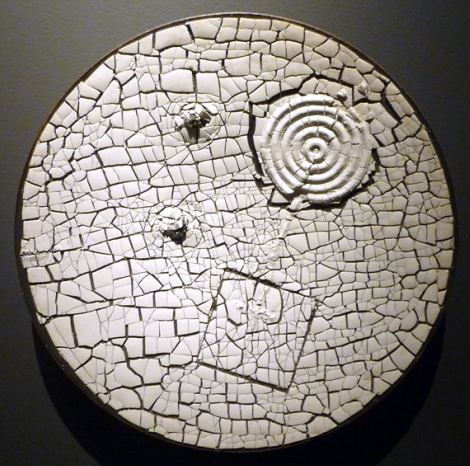 His glory is his mud and foam, his crackled white slip on ash-gray stoneware plates, platters and ceramic tiles. The force of gesture
frozen on the surface distills both freedom and a certain kind of Asian
restraint. Within narrow restraints, he opened up a range of
aesthetic possibilities, usually in flat gray under cracked white but sometimes gold patterned with white.
His glory is his mud and foam, his crackled white slip on ash-gray stoneware plates, platters and ceramic tiles. The force of gesture
frozen on the surface distills both freedom and a certain kind of Asian
restraint. Within narrow restraints, he opened up a range of
aesthetic possibilities, usually in flat gray under cracked white but sometimes gold patterned with white.Platter
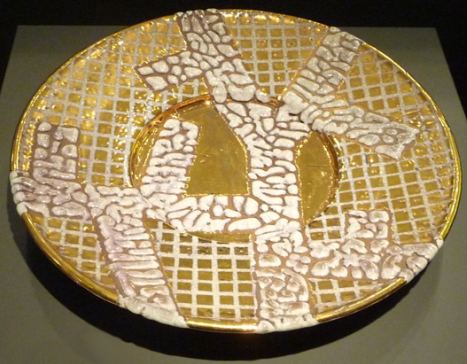 Through Jan. 31.
Through Jan. 31.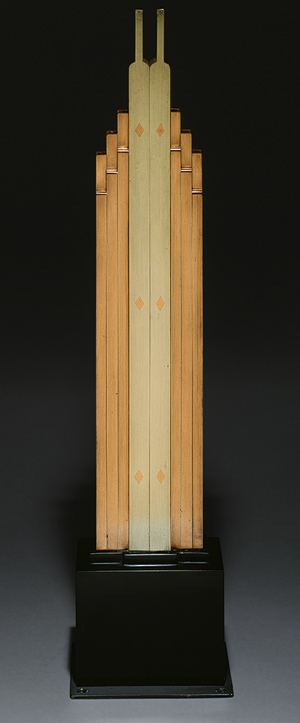 John Buck,
Skyline edition 4/15
2000 - 2002
Four-color woodcut
92 x 37 in. In his exhibit at the Bellevue Arts Museum through Feb. 28.
John Buck,
Skyline edition 4/15
2000 - 2002
Four-color woodcut
92 x 37 in. In his exhibit at the Bellevue Arts Museum through Feb. 28.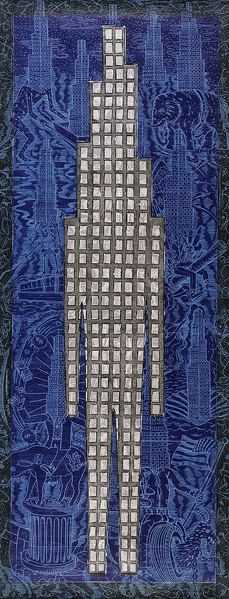
Art extends from order to chaos and generates waste as it transforms it.
Hans Haacke's News on November 5th, 2008, when Art of Participation opened at SFMOMA
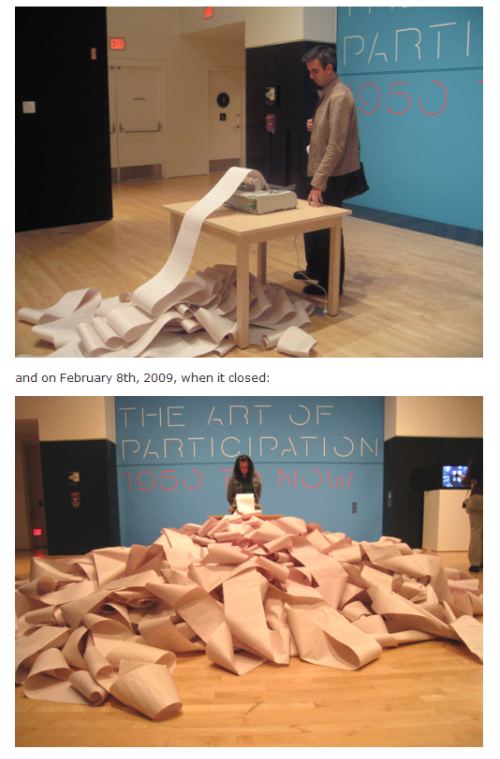 Christian Marclay, Tape Fall, 1989
Christian Marclay, Tape Fall, 1989 Claude Zervas, Cumulus, 2002
Claude Zervas, Cumulus, 2002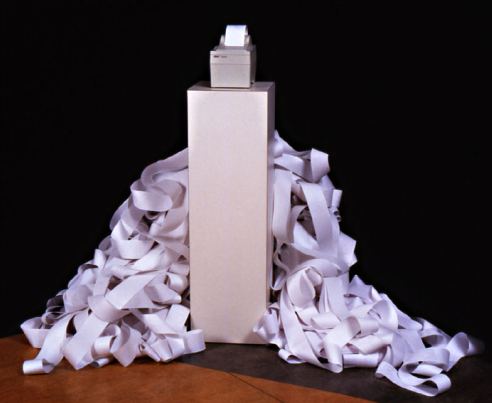
To bronze an object is to cherish it, a baby's shoe, a fishing lure, a first blanket. What SuttonBeresCuller cherish is the absurdity of elitism, the attempt to sever ties that bind and assert the ones the separate: this Leonardo, not the one on its right; this arthritic old king, not that blooming young peasant.
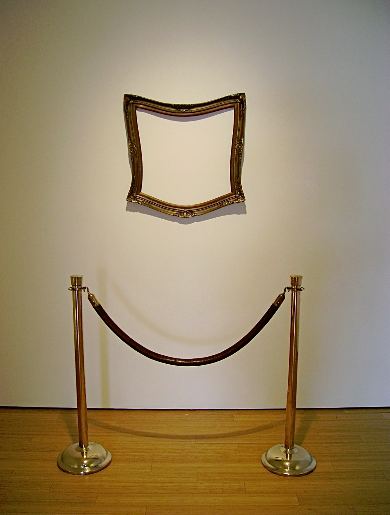 Part of their exhibit at Lawrimore Project, through Dec. 19. My review here.
Part of their exhibit at Lawrimore Project, through Dec. 19. My review here.She has voice, rhythm, confidence and depth, all present and accounted for on her blog, Style Rookie, which she started when she was 12.
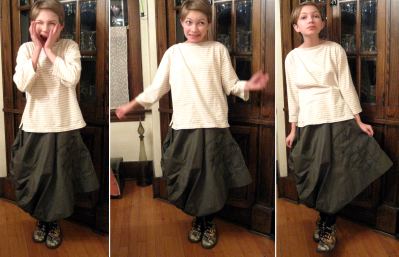 Here's her description of herself:
Here's her description of herself:Tiny 13 year old dork that sits inside all day wearing awkward jackets and pretty hats. Scatters black petals on Rei Kawakubo's doorsteps and serenades her in rap. I have no where near 4 million readers. Rather cynical and cute as a drained rat. In a sewer. Farting. And spitting out guts.She aced her interview last year on Teen Vogue.
No white skin, no service: Tottle House... Occupied During Sit-in, 1963 Silver Gelatin Print 11" x 14"
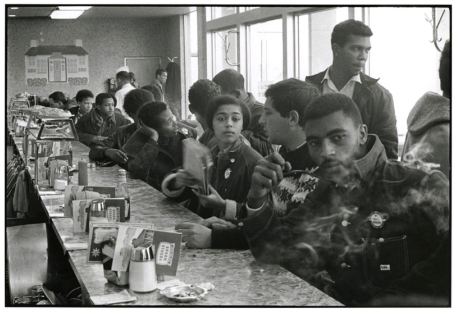 It's all there: casual clarity fused with formal rigor.
It's all there: casual clarity fused with formal rigor.Randy Kennedy:
At the James Harris Gallery are 17 of Lyon's vintage highlights, 1962 to 1972.
Like Larry Clark, who blurred the line between observer and participant and wanted to confront middle-class viewers with the American underclass, Mr. Lyon has made a peripatetic attempt to photograph people who are generally unseen or unwanted, even hated, and he has never been able to approach it with a journalist's distance.
Rt. 12, Wisconsin, 1963 Silver Gelatin Print 11" x 14"
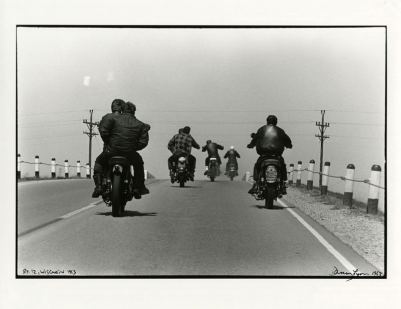 The Line, Ferguson Unit, 1967/8
Silver Gelatin Print
11" x 14"
The Line, Ferguson Unit, 1967/8
Silver Gelatin Print
11" x 14"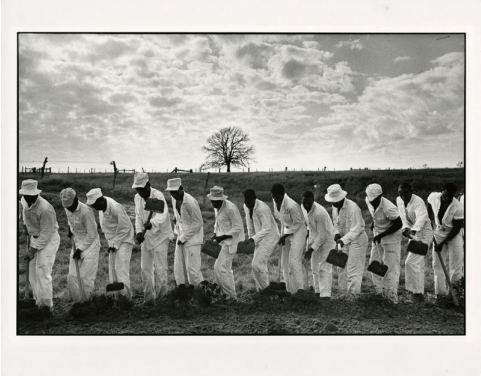 Through Dec. 19.
Through Dec. 19.Attoe
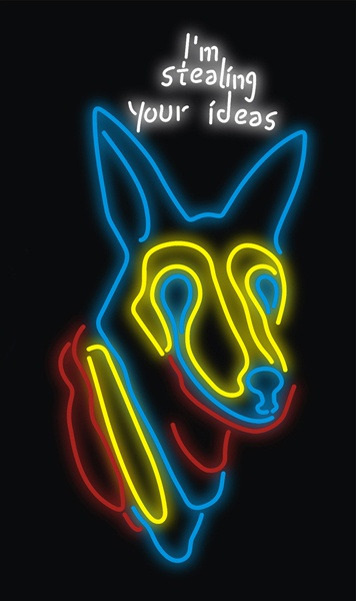
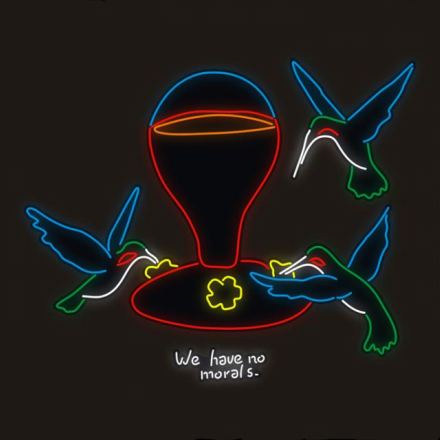
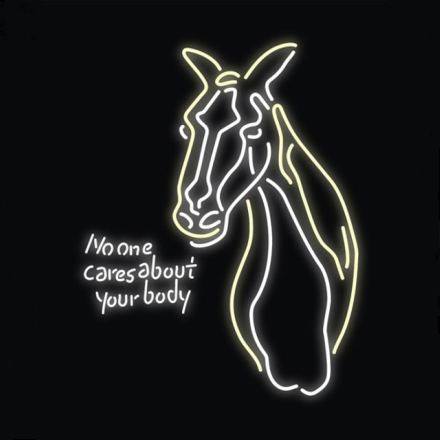 Not online is the text of the piece Rosenfeld cited: We're all here because we were too afraid to deal with problems in our real lives.
Not online is the text of the piece Rosenfeld cited: We're all here because we were too afraid to deal with problems in our real lives.
The desire to keep oneself to oneself has practical roots. In the 17th century, for instance, pioneers of the merchant class learned to avoid angering the samurai with overt displays of wealth. Even the most successful shop owners wore coarse cotton jackets in dark colors. Inside, however, the jackets were lined in richly colored silks embroidered with peonies, cranes and craggy pines.
Following in a long line of Zen priests and Neo-Dada figures such as Ushio Shinohara, Meiro Koizumi is extraordinarily good at cracking an emotionally impassive surface. Once the surface is cracked, he's the equivalent of a crime scene reporter at Bruce Nauman's Clown Torture, not as interested in the wailing as in the reasons for it.
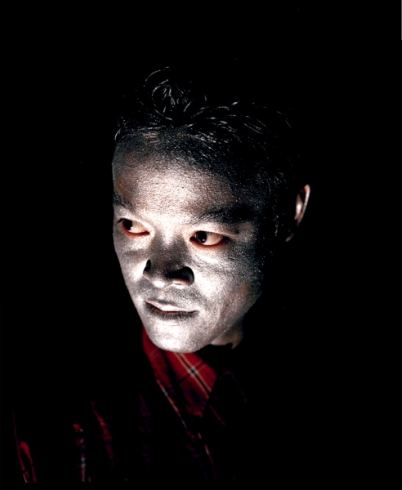 Thanks to curator Yoko Ott, there are two opportunities for depth viewing of Koizumi's production: My Voice Would Reach You, A Survey of his First Ten Years, 2000-2009 at Seattle University's Hedreen Gallery, and The Corner of Sweet and Bitter at Open Satellite.
Thanks to curator Yoko Ott, there are two opportunities for depth viewing of Koizumi's production: My Voice Would Reach You, A Survey of his First Ten Years, 2000-2009 at Seattle University's Hedreen Gallery, and The Corner of Sweet and Bitter at Open Satellite. Two from Hedreen:
Mum features a young man on the phone listening to his mother. From his responses, we know it's a series of button-down mom exchanges.The sun is shining; Dad's working hard; she wonders if her son ate the vegetables she sent him. He mumbles through his end of the conversation but tells her he has something to say. After the conventional set up, the impact of his visceral performance is profound. It's the deep end of the emotional ocean.
For Human Opera XXX, Koizumi placed at ad in a Northern European newspaper, asking for volunteers willing to be filmed as they tell a sad life story. The piece is an engagement between subject, artist and camera. As the volunteer speaks, Koizumi insists he continue his tale with props to provide appropriate resonance. From love affair to daughter to drinking problem to sobriety to utter loss, the man reluctantly allows Koizumi to enfold him in props that peel the skin off his story.
 The Bellevue Problem: Plenty of people in Seattle go to the Hedreen Gallery or are at least theoretically willing to go to the Hedreen Gallery and hope they remember before this show closes. Only a fraction of those see the need to go to Open Satellite, because it's in Bellevue. Besides, if ten years of the artist's work is in Seattle, why cross Lake Washington to see a single piece from far, far away?
The Bellevue Problem: Plenty of people in Seattle go to the Hedreen Gallery or are at least theoretically willing to go to the Hedreen Gallery and hope they remember before this show closes. Only a fraction of those see the need to go to Open Satellite, because it's in Bellevue. Besides, if ten years of the artist's work is in Seattle, why cross Lake Washington to see a single piece from far, far away?Because it's an installation rooted in Northwest history. Its cities were not built on rock and roll but on the labor of Asian immigrants. Japanese-Americans cleared the ground in Bellevue and Vashon Island for farmlands, uprooting stumps and planting endless rows of strawberries. Although Vashon Island still celebrates its roots with an annual Strawberry Festival, there are no commercially grown strawberries on the island since World War II. On Feb. 19, 1942, with Executive Order 9066, Japanese and Japanese Americans living on the West Coast were arrested and relocated to internment camps.Who was willing to do the back-breaking labor after they left? Apparently, nobody.
To honor them, Koisumi half-built a house and surrounded it with strawberry fields. Inside the house is a video screen. A young Mexican American plays The Star Spangled Banner on a homemade trumpet taped to his mouth. As he plays, the American flag ripples across his face.The text is a stream of admonitions to work hard. With noses to grindstones and shoulders to wheels, efforts are rewarded, right? The cumulative effect of this piece is overwhelming.
(Photos: Malcolm Smith)
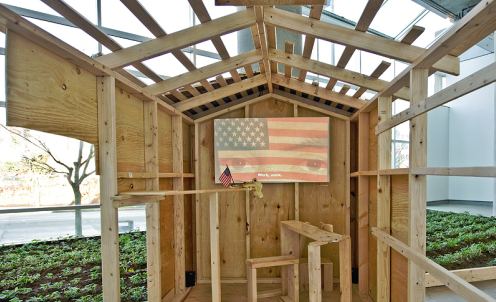
 Both exhibits through Jan. 9.
Both exhibits through Jan. 9.C.K. Wilde
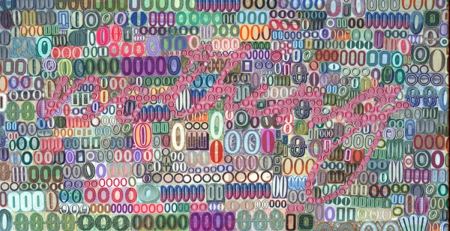 Even when it delivers, artists tend to get the short end.
Even when it delivers, artists tend to get the short end.SuttonBeresCuller, Distribution of Wealth. From left to right, costs of fabrication, dealer cut and artist cut divided by three, because there are three of them. (Through Dec. 19 at Lawrimore Project)
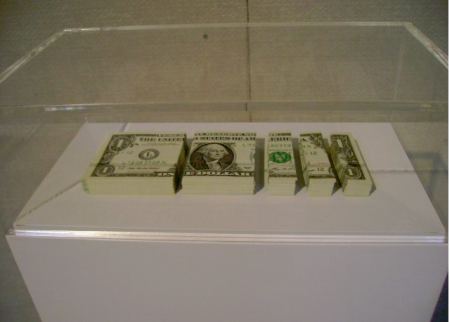 From Troy Gua, the forklift version of Cabaret.
From Troy Gua, the forklift version of Cabaret.
(Image via)
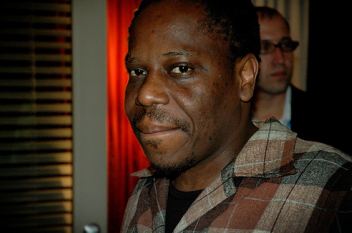 Now a Seattle screenwriter and writer/editor at the Stranger, Mudede will talk about his musical education and its impact on his family in a lecture he's calling Twilight of the Goodtimes at Western Bridge, Dec. 9. at 7 p.m. The lecture reflects the theme of Western Bridge's current exhibit, Parenthesis, about mothers and fathers, daughters and sons. (My review here.)
Now a Seattle screenwriter and writer/editor at the Stranger, Mudede will talk about his musical education and its impact on his family in a lecture he's calling Twilight of the Goodtimes at Western Bridge, Dec. 9. at 7 p.m. The lecture reflects the theme of Western Bridge's current exhibit, Parenthesis, about mothers and fathers, daughters and sons. (My review here.)In visual art, following Wambaugh, I note their passing with donuts.
Claire Johnson
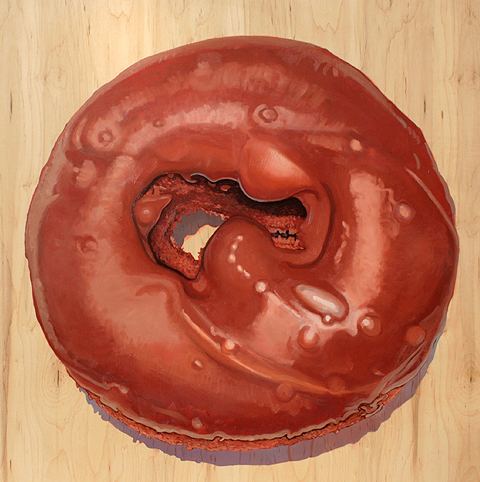 Spike Mafford
Spike Mafford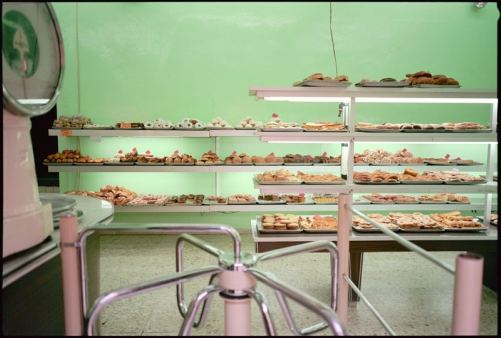 Kenny Scharf
Kenny Scharf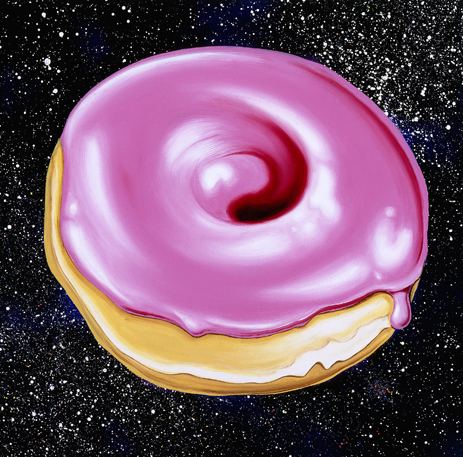 Emily Eveleth (Via Olive Oil)
Emily Eveleth (Via Olive Oil)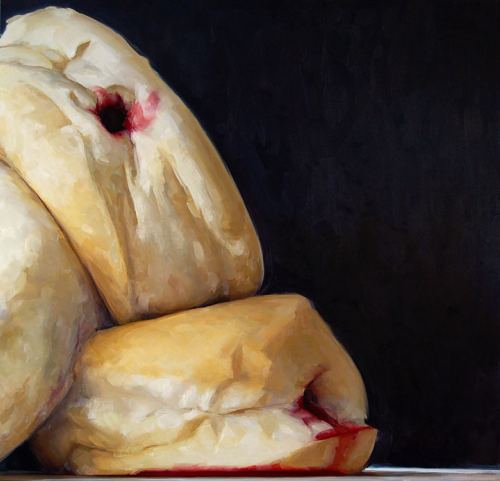
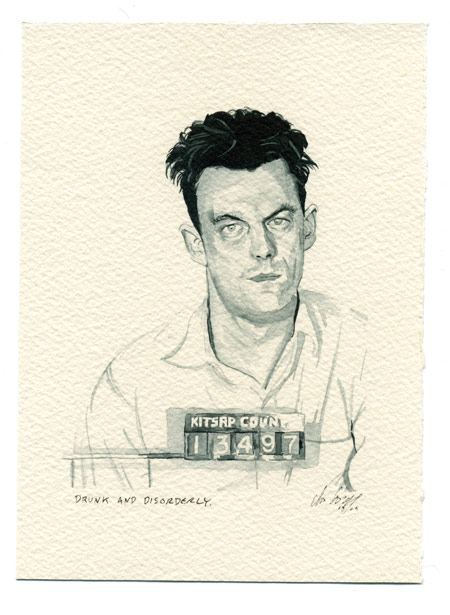
By the rules of the art road, he has nothing in common with Todd Simeone, a Chicago photographer and video artist who shows in Seattle at James Harris. And yet....
Miller:
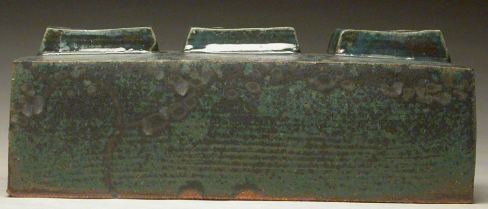
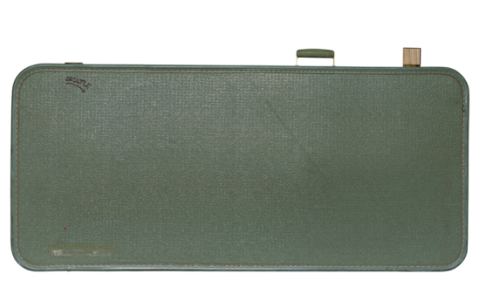 Does what you call it determine what it is?
Does what you call it determine what it is?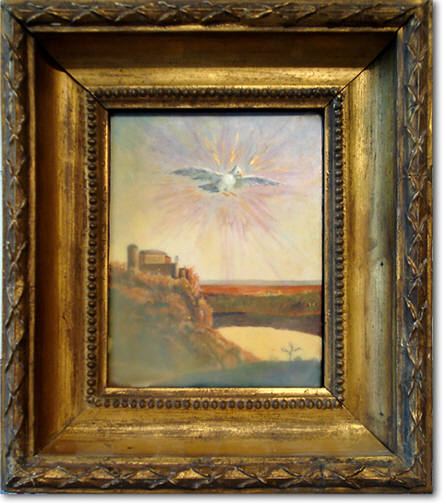 Gerald Manley Hopkins
Gerald Manley Hopkins
Because the Holy Ghost over the bent
World broods with warm breast and with ah! bright wings.
From BNET:
A consummate communicator, Archbishop Ravasi has written, always by longhand, 150 books as well as countless articles and is an accomplished television and radio performer. Usually, his subject is the Bible, but he has also commented both on current affairs and cultural issues for several Italian dailies. His range and clarity are exceptional. He links the Bible with figures such as the Russian poet Vladimir Mayakovsky, with Hindu holy books, with the controversial Jesuit paleontologist Pierre Teilhard de Chardin, with the Lebanese poet Kahlil Gibran, with the modern folk singer Fabrizio D'Andrea.Archbishop Ravasi is behind the Pope's call for a reengagement between artists and the Catholic Church. (New York Times story here.)
Five hundred years ago, when the Church was responsible for commissioning the greatest work in the Western World, top artists had few choices in patrons. Today, in a wider world, it might be hard to attract their contemporary equivalents.
Christopher Hitchens offers reasons why as well as a potential solution. This is Hitchens at his best. Raised Catholic, no, boiled in it like leaves of tea, I watched both videos alone and clapped when each was over, the sound echoing in my empty room.
August Sander: from Peasant Children, Westerwald 1926-31 (Image via)
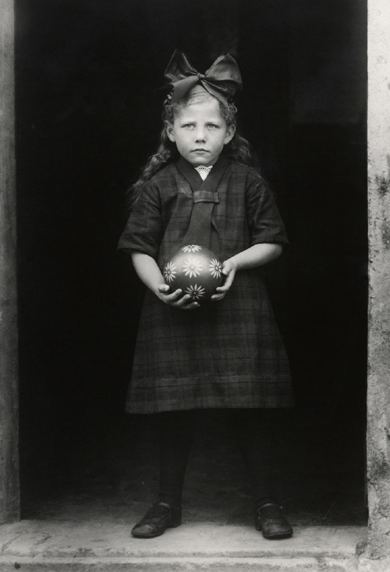 Claudette Schreuders, Anna,
Yelutang wood and enamel paint, 2008
Claudette Schreuders, Anna,
Yelutang wood and enamel paint, 2008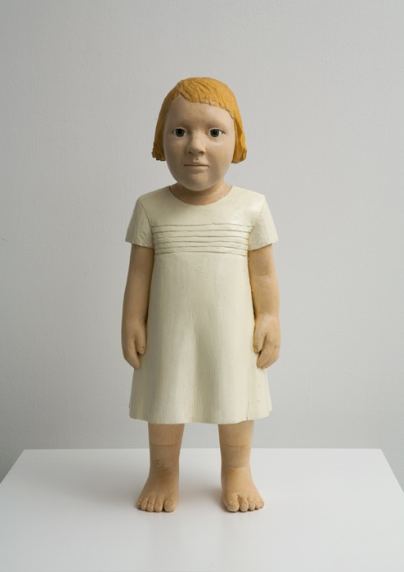
In late 1960s, Carl Andre claimed the space (from floor to ceiling) over his lead and copper squares. When you walked on them, you were in and on his art.
More recently in flooring:
Do-Ho Suh
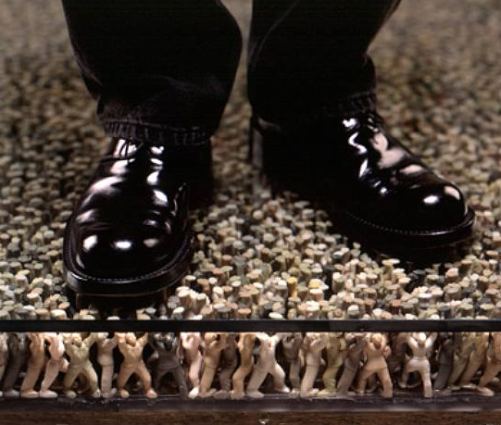 Christian Marclay
Christian Marclay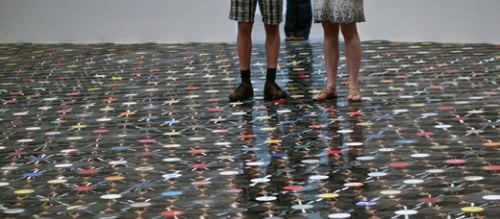 Leo Saul Berk
Leo Saul Berk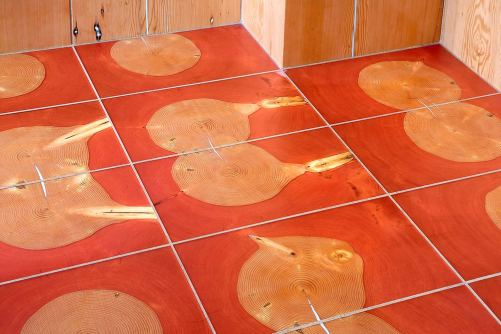
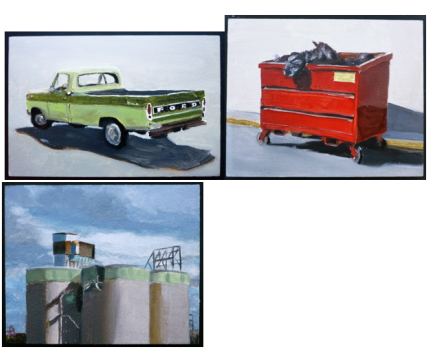
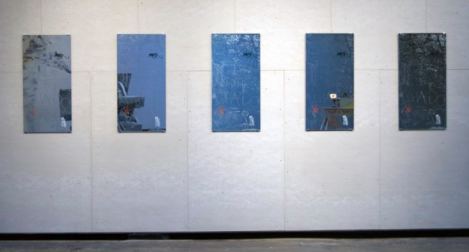 Everyone is an Artist, The Summit, 2009
Acid etching and acrylic on mirror of an original taken
from The Summit Public House
36 x 18 inches
Everyone is an Artist, The Summit, 2009
Acid etching and acrylic on mirror of an original taken
from The Summit Public House
36 x 18 inches

The continent's imperiled rims therefore become a new kind of landscape, the Involuntary Parks. They are not representations of untouched nature, but of vengeful nature, of natural processes reasserting themselves in areas of political and technological collapse. An embarrassment during the twentieth century, Involuntary Parks could become a somber necessity during the twenty-first.
Here she is on painter David Kane:
"Farewell to Mars and Other Paintings" is Kane's first show "since all that happened," (meaning his diagnosis, treatment, and recovery from lung and thyroid cancer...) Some of the canvases in the show were begun ten years ago, set aside and picked up again; others are entirely new. Allusions to the battle with cancer can be read throughout the show in saucers, moons and suns that look like cells, in the scorched earth and the struggle of flesh and technology.
In "Farewell to Mars", a priapic alien herma gives a three-fingered wave to a trio of flying saucers soaring like so many platelets in the purple skies of a red planet. It's a hopeful sign.
Kane's painting, as always, is intellectually and pictorially brilliant, going far beyond the personal. He plays with spatial recession, atmospheric effects, and deceptively tight compositions, pulling from 18th-century Venetian vedute painters (think Canaletto), depression-era regionalism (think Benton and Hopper), '50s pulp sci-fi illustration, and apocalyptic fundamentalist religious tracts (rapture merges with alien abduction) to reference classical myth and rationalism, post-war atomic-age conformity, environmental disaster, and the war-ravaged sands of the Middle East. (more)
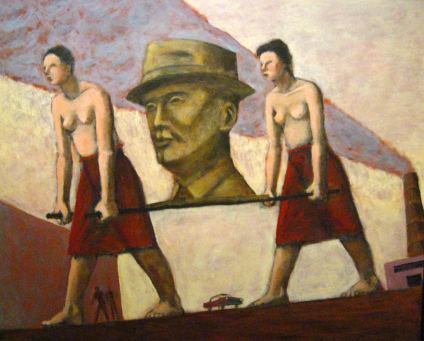 Canaletto? Not even a little bit. I can see Benton without the rhythm and Hopper without the light, however. Kane's paintings look as if he made them with caked powders on sandpaper. In their choked aridities, in their coarse forms and muddy colors, there is something genuine, a real toad in his imaginary garden. Bryant is thunderously wrong in what she sees in him, but I enjoyed reading every word. She's that rare critic who lives not because of her judgments but in spite of them.
Canaletto? Not even a little bit. I can see Benton without the rhythm and Hopper without the light, however. Kane's paintings look as if he made them with caked powders on sandpaper. In their choked aridities, in their coarse forms and muddy colors, there is something genuine, a real toad in his imaginary garden. Bryant is thunderously wrong in what she sees in him, but I enjoyed reading every word. She's that rare critic who lives not because of her judgments but in spite of them.The usual Seattle sources covered it, but not well.
Paul Constant at the Stranger was more interested in griping that he didn't get full credit from the Seattle Times for being first as the news breaker. (Constant was much better on the demise of Bailey/Coy Books, which like the Stranger is on Capitol Hill. Bailey/Coy is a lovely little store, but compared to Elliott Bay, its significance is tiny.)
The online Seattle Post-Intelligencer, a ghost of its former self, has no interest in culture. Is the Seattle Times being written from Seattle? Its story on Elliott Bay's economic impact to Pioneer Square's arts presence missed the Square's essential cultural identity. Besides being a haven for readers thanks to Elliott Bay, that's where nearly all of the city's major art galleries are located.
On Crosscut, Knute Berger was better than the ST on the economic impact, but again, does he live here?
Berger:
If the blend of street life in Pioneer Square is largely the homeless, bar patrons, and seasonal tourists, add to that mix sports fans, not necessarily a book-buying crowd.Galleries, big guy, galleries. The visual art crowd hits those streets, Tuesdays through Saturdays.
What difference does it make? Anyone who's interested has heard the news: Elliott Bay is either going down or moving to Capitol Hill . That's where the LA Times' story comes in. What is the character of this particular store? Breath and depth, ladies and gentlemen. Breath and depth.
OTHER NEWS....
Put on a happy face: The best graphic for Art/Basel/Miami Beach, opening Wednesday, comes from C-Monster, here. ("Miami, Where Art Sweats. From the Department of Public Relations and Extra Marital Affairs.") Enough with the sobbing. Make it work.
Shudder: The Art World Edition of 7 Habits of Highly Effective People here. I remember when everyone at the Seattle Times was required to read 7 Habits, and I (once again) gave thanks that I worked at the PI. The PI's unruly newsroom would have dropped kicked that order into a dumpster.
Richard Lacayo is pulling the plug on his excellent blog, Looking Around. Why? Maintaining a one-person blog of that quality is a lot of work. Missing from Lacayo's sign-off is any acknowledgment that his blog made him. He had worked for Time for decades and was largely ignored, except in architectural criticism circles, laboring as he was under the large shadow of Robert Hughes. With Looking Around, he became a national figure. Here's hoping his reasonable and intelligent voice continues to be prominent once dropped back into the Time pool. (Who reads Time? Ever? Anybody?)
From Kenneth Baker, why what art critics see at major exhibitions is different than anyone else, here.
Congratulations! Seattle's Jen Graves wins a Warhol grant, here. (Other winners here.)
Stuart Sherman is back, here. When an artist such as Sherman dies neglected and remains neglected, it is a sign that the art world being driven by the market. His reemergence means the opposite. Maybe the recession is not all bad.
Houston's Douglas Britt loves Dario Robleto, here. Britt goes the extra mile for his home town hero, traveling on his own dime to see Robleto shows beyond Texas, including one in Seattle.
Private property is (art) theft, here. Buying the land on which a key Richard Serra rests shouldn't mean you get to wreck it through neglect and deny access to the public. Tyler Green reports that at least the owners won't be able to demolish it, here.
Kyle MacMillan does a fine job of saying goodbye to the retiring director of the Denver Art Museum, here.
Alexandra Silverthorne has a fresh approach to litter left in a park, here. (Love the white plastic spoon in the bushes.)
About
Blogroll
AJ Blogs
AJBlogCentral | rssculture
Terry Teachout on the arts in New York City
Andrew Taylor on the business of arts & culture
rock culture approximately
Laura Collins-Hughes on arts, culture and coverage
Richard Kessler on arts education
Douglas McLennan's blog
Dalouge Smith advocates for the Arts
Art from the American Outback
Chloe Veltman on how culture will save the world
For immediate release: the arts are marketable
No genre is the new genre
David Jays on theatre and dance
Paul Levy measures the Angles
Judith H. Dobrzynski on Culture
John Rockwell on the arts
innovations and impediments in not-for-profit arts
Jan Herman - arts, media & culture with 'tude
dance
Apollinaire Scherr talks about dance
Tobi Tobias on dance et al...
jazz
Howard Mandel's freelance Urban Improvisation
Focus on New Orleans. Jazz and Other Sounds
Doug Ramsey on Jazz and other matters...
media
Jeff Weinstein's Cultural Mixology
Martha Bayles on Film...
classical music
Fresh ideas on building arts communities
Greg Sandow performs a book-in-progress
Harvey Sachs on music, and various digressions
Bruce Brubaker on all things Piano
Kyle Gann on music after the fact
Greg Sandow on the future of Classical Music
Norman Lebrecht on Shifting Sound Worlds
Joe Horowitz on music
publishing
Jerome Weeks on Books
Scott McLemee on books, ideas & trash-culture ephemera
theatre
Wendy Rosenfield: covering drama, onstage and off
visual
Public Art, Public Space
Regina Hackett takes her Art To Go
John Perreault's art diary
Lee Rosenbaum's Cultural Commentary

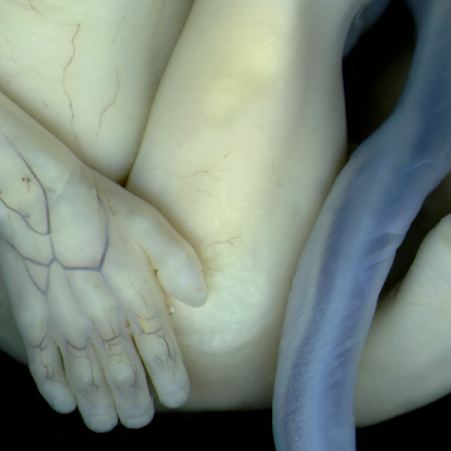


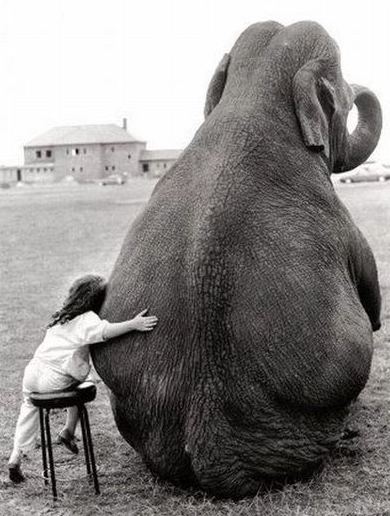


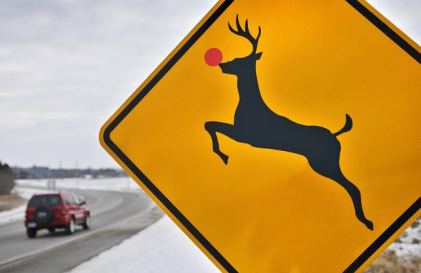
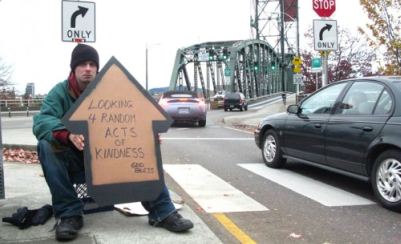
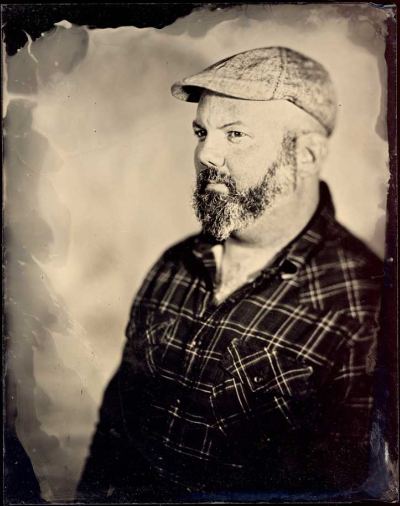
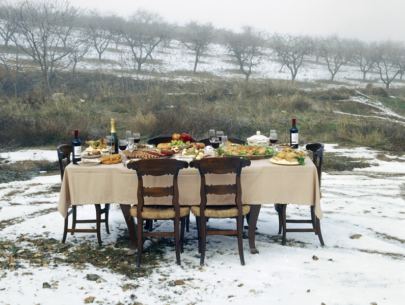
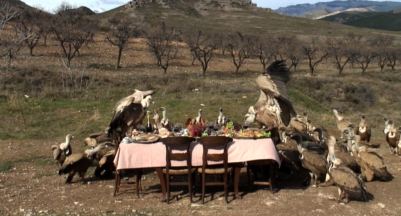
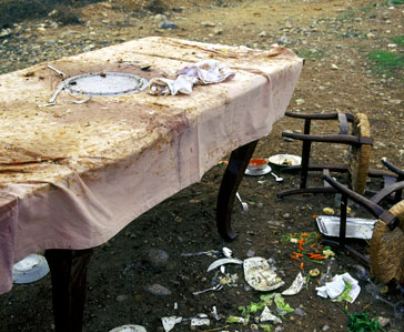 Video
Video 
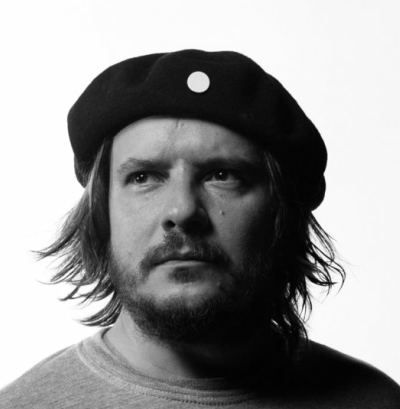
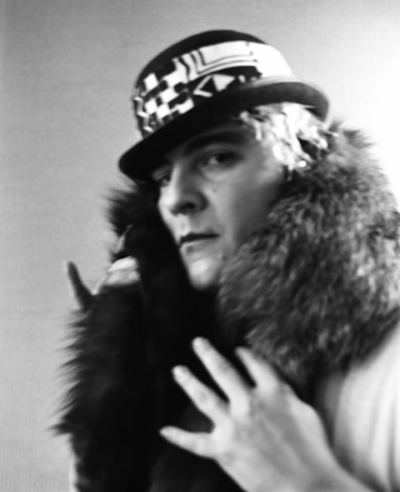
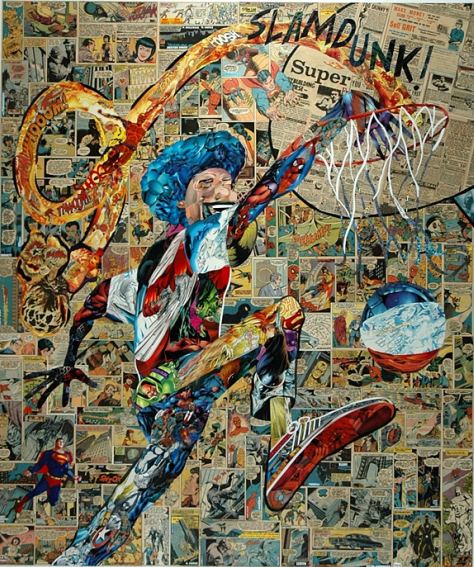

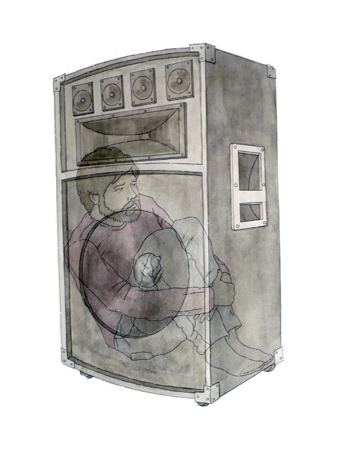
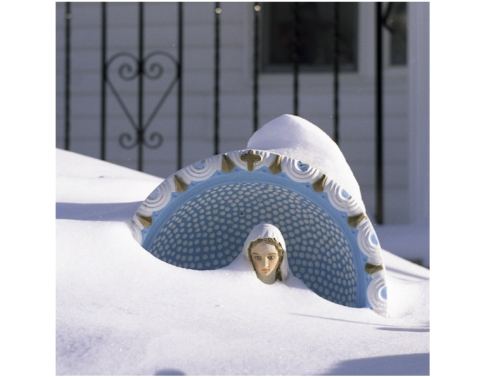


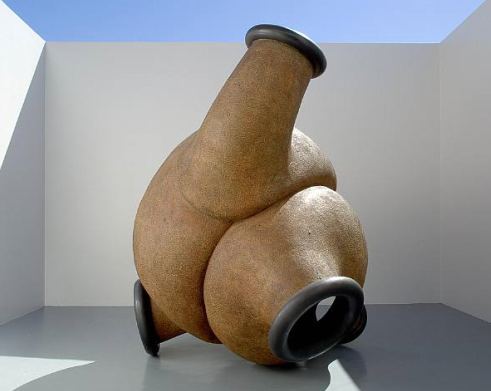
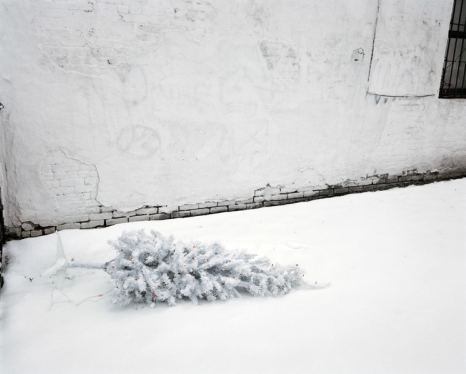
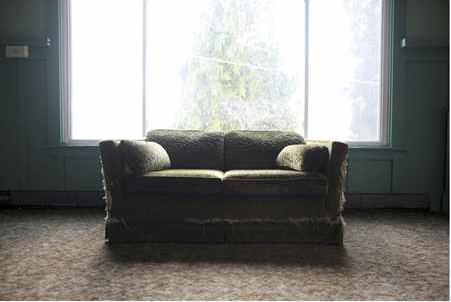
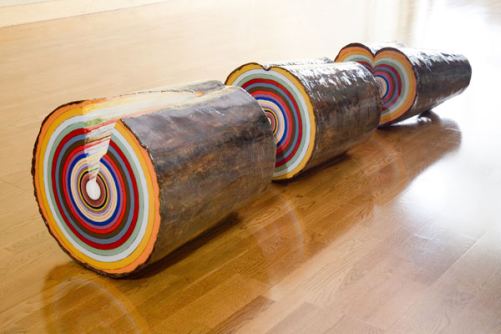
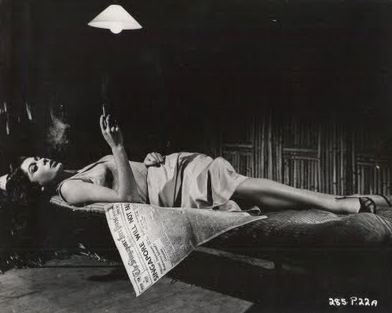
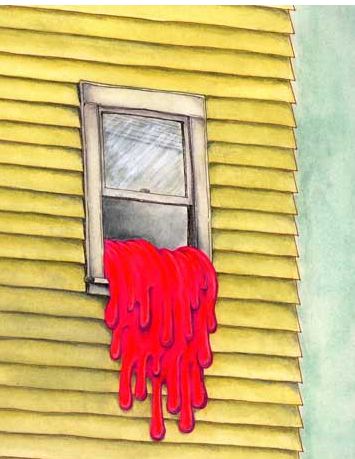
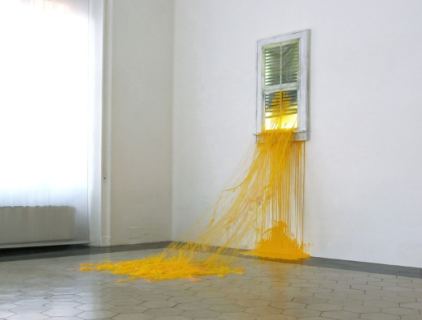
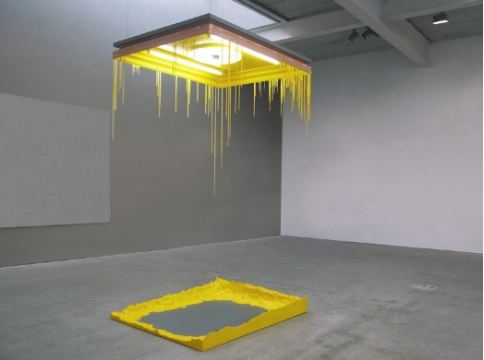
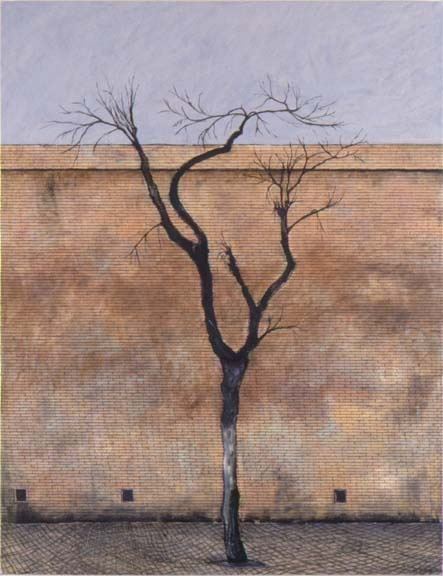
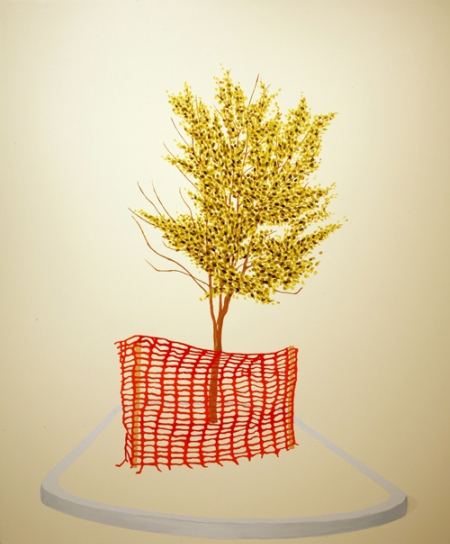
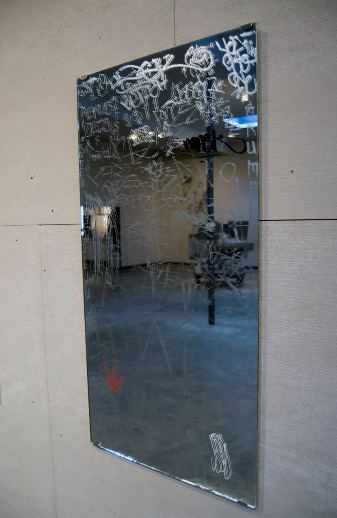
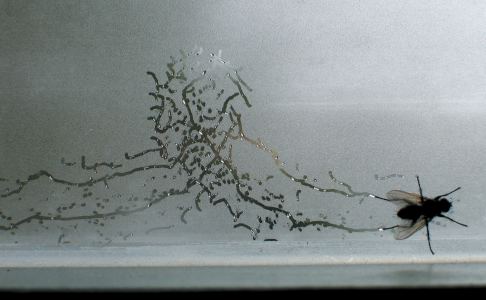
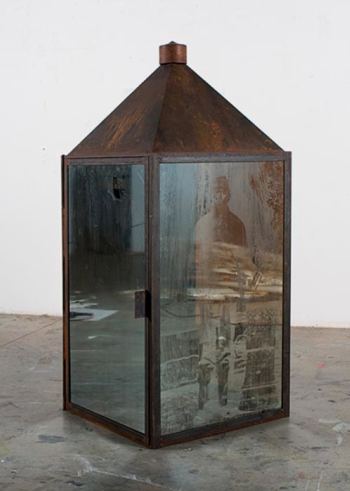
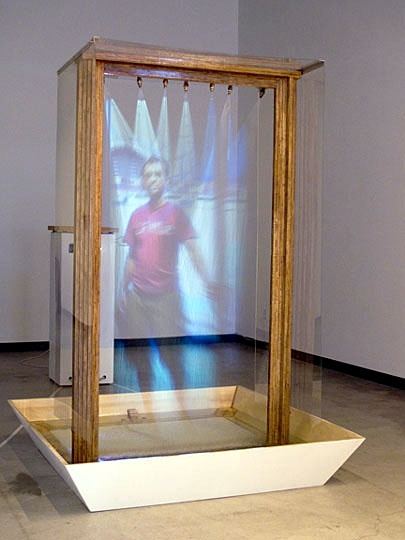
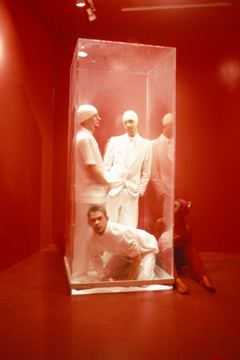

Recent Comments